 Types of Elk
Types of Elk
Types of Elk
In the United States, there are four subspecies of elk recognized:

- Rocky Mountain Elk (Cervus canadensis nelsoni): The Rocky Mountain Elk is the most widespread subspecies and is found in various western states. Its range includes Colorado, Idaho, Montana, Oregon, Utah, Washington, Wyoming, and parts of British Columbia, Alberta, and Saskatchewan in Canada.
- Roosevelt Elk (Cervus canadensis roosevelti): Roosevelt Elk is found primarily along the Pacific Coast in the states of California, Oregon, and Washington. They inhabit the coastal forests and are named after President Theodore Roosevelt.
- Tule Elk (Cervus canadensis nannodes): The Tule Elk is native to California and is found in the Central Valley and surrounding areas. Their population was once critically low, but conservation efforts have helped increase their numbers.
- Manitoban Elk (Cervus canadensis manitobensis): Manitoban Elk, also known as Eastern Elk, was historically found in parts of the Midwest and Eastern regions of the United States. However, they were extirpated from these areas and are now primarily found in Manitoba, Canada.
Each subspecies has distinct characteristics that set them apart:
Rocky Mountain Elk: This subspecies is known for its large body size, impressive antler development, and varied coat colors. They are adaptable to a range of habitats and are highly sought after by hunters.
Roosevelt Elk: Roosevelt Elk are the largest subspecies of elk in North America. They have darker coats, long antlers, and are well-adapted to the dense forests along the Pacific Coast.
Tule Elk: Tule Elk are the smallest subspecies of elk, adapted to the grasslands and marshes of California. They have a light coat color and compact antlers.
Manitoban Elk: This subspecies, now primarily found in Canada, had historically roamed the Midwest and Eastern United States. They were larger than the other subspecies, with significant antler size and body mass.
As for specific population numbers and distributions in each state, it’s important to note that elk populations can fluctuate due to various factors, including hunting, habitat changes, and conservation efforts. It’s recommended to refer to recent wildlife management reports, state agencies, or organizations dedicated to elk conservation for the most accurate and up-to-date information on elk populations in each state. Best States for Hunting Elk
Each Type of Elk in the United States Major Characteristics
Rocky Mountain Elk
The Rocky Mountain Elk: Majesty of the Western Wilderness
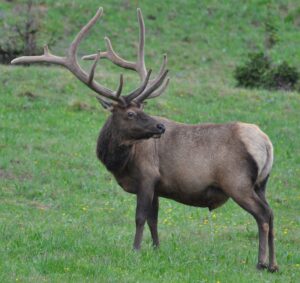
Rocky Mountain Elk https://www.flickr.com/photos/50764314@N04
Introduction: The Rocky Mountain Elk (Cervus canadensis nelsoni) is an iconic and majestic species that roams the vast expanses of the western United States and parts of Canada. With its impressive antlers, regal stature, and captivating presence, the Rocky Mountain Elk has captured the hearts and imaginations of wildlife enthusiasts, photographers, and hunters alike. In this article, we will explore the habitat, diet, and mating season of the Rocky Mountain Elk, shedding light on the captivating aspects of this remarkable creature.
Habitat and Range: As the name suggests, the Rocky Mountain Elk primarily inhabits the Rocky Mountain region of North America. Their range extends across several western states, including Colorado, Idaho, Montana, Oregon, Utah, Washington, Wyoming, and parts of British Columbia, Alberta, and Saskatchewan in Canada. These vast and diverse landscapes provide an ideal environment for elk, with rugged mountains, expansive forests, and wide-open grasslands offering ample opportunities for foraging, shelter, and survival.
Diet and Foraging Habits: The Rocky Mountain Elk is a herbivorous species with a varied and adaptable diet. Their primary food sources consist of grasses, forbs, shrubs, and browse vegetation. During the summer months, elk graze on abundant grasses and forbs found in open meadows and alpine areas. As the seasons change and food availability shifts, they also browse on shrubs, tree bark, and twigs. Elk have a unique ability to extract nutrients from nutrient-poor forage, allowing them to thrive in diverse habitats.
Mating Season and Rut: The mating season, also known as the rut, is a fascinating and crucial time in the life of Rocky Mountain Elk. It typically occurs during the fall months, with specific timing varying depending on the region and environmental factors. The rut is characterized by intense social interactions, vocalizations, and displays of strength among the males, as they compete for the attention and mating rights with females.
During the rut, bull elk undergo remarkable physical transformations. They develop a thicker neck and shoulder muscles, which enhance their ability to fight and defend their harem of females. One of the most iconic features of the Rocky Mountain Elk is the bull’s antlers, which reach their peak size and complexity during this time. These antlers are used both as weapons in battles for dominance and as visual displays to attract mates.
The vocalizations of elk during the rut are also striking. Bulls emit a resonant bugling call that carries through the mountain valleys, serving as a declaration of their dominance and a signal to competing males. Bugles can vary in pitch and intensity, conveying information about a bull’s size, strength, and reproductive fitness. This vocal symphony adds a captivating layer to the wild landscapes where elk reside.
The competition for mating rights can be intense, with rival bulls engaging in elaborate displays of dominance. They clash antlers, lock horns, and engage in physical confrontations to establish their hierarchy and secure access to receptive females. These battles can be fierce, with the clashing of antlers echoing through the wilderness. The victors of these battles earn the privilege of mating with a group of females, known as a harem.
Once a bull successfully establishes dominance, he actively seeks out receptive females, or cows, within his harem. The cows play a critical role in the mating process as well. They communicate their reproductive readiness through a series of behaviors and pheromone signals. A cow will choose a dominant bull based on his strength, size, and display of fitness.
The Rocky Mountain Elk mating season is not only a spectacle of natural beauty but also a crucial event for the species’ reproductive success. The genetic diversity and health of the population depend upon successful conditions for mating.
Roosevelt Elk
The Roosevelt Elk: Majesty of the Pacific Coast
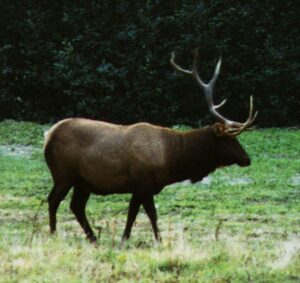
Roosevelt Elk
https://www.flickr.com/photos/39108150@N05
Introduction: The Roosevelt Elk (Cervus canadensis roosevelti) is a magnificent and awe-inspiring creature that roams the coastal regions of the Pacific Northwest. Known for its large size, majestic antlers, and affinity for dense forests, the Roosevelt Elk captivates the hearts and imaginations of nature enthusiasts, photographers, and wildlife lovers. In this article, we will delve into the habitat, diet, and mating season of the Roosevelt Elk, unraveling the captivating aspects of this remarkable subspecies.
Habitat and Range: The Roosevelt Elk primarily inhabits the coastal regions of California, Oregon, and Washington, where it thrives in the diverse ecosystems along the Pacific Coast. These areas are characterized by dense forests, rugged terrain, and ample water sources, creating an ideal habitat for the elk. The Roosevelt Elk’s range spans from the coastal lowlands to the subalpine regions of the coastal mountain ranges, allowing them to explore a variety of habitats within their territory.
Diet and Foraging Habits: Roosevelt Elk are herbivorous animals with a diverse and adaptable diet. They consume a wide range of vegetation, including grasses, forbs, shrubs, ferns, and tree bark. Their ability to browse on various plant species enables them to find sustenance in the dense forests they call home. During the summer months, when meadows and open areas are abundant, they graze on grasses and forbs. As the seasons change and food availability fluctuates, they shift to browsing on woody vegetation, including shrubs and tree branches.
Mating Season and Rut: The mating season, also known as the rut, is a significant period in the life of Roosevelt Elk. It typically occurs during the fall months, usually between September and October. The timing of the rut can vary depending on environmental factors, such as food availability and weather conditions, as well as the individual’s age and condition.
During the rut, male Roosevelt Elk, known as bulls, engage in intense competitions for mating rights with females, or cows. This is a time of heightened activity, vocalizations, and displays of strength and dominance. Bulls undergo remarkable physical changes, such as developing a thicker neck and shoulder muscles, which enhance their ability to fight and establish dominance.
One of the most captivating aspects of the Roosevelt Elk rut is the bulls’ majestic antlers. These antlers can reach impressive sizes, with multiple points and immense spans, serving as visual displays and weapons during battles for dominance. The size and complexity of antlers are key factors in determining a bull’s rank within the hierarchy and attracting mates.
Vocalizations play a vital role in the rutting behavior of Roosevelt Elk. Bulls emit a resonant bugling call that reverberates through the dense forests and valleys. Bugling serves as a way for bulls to establish their presence, communicate with females, and challenge rival males. The bugle is a haunting and powerful sound that adds a captivating element to the coastal landscapes where Roosevelt Elk reside.
During the rut, bulls engage in physical confrontations to assert dominance and win mating rights. These battles can be intense, with clashing antlers and displays of strength. The fights are not only determined by physical attributes but also by behavioral cues and intimidation tactics. The victorious bull earns the privilege of mating with a group of receptive females.
Within the hierarchy established during the rut, bulls maintain a harem of cows. The cows play an essential role in the mating process as well. They communicate their receptivity through behavior and scent cues, indicating their readiness to mate. The dominant bulls, with their size, strength, and display of fitness, attract the attention and preference of the cows.
The mating season of Roosevelt Elk is a remarkable natural spectacle
The Tule Elk: Resilience of California’s Grasslands
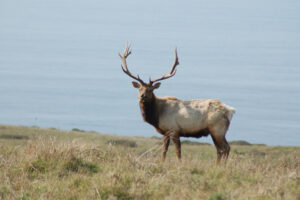
Tule Elk
https://www.flickr.com/photos/48372717@N00
Introduction: The Tule Elk (Cervus canadensis nannodes) is a remarkable subspecies of elk that holds a significant place in California’s natural heritage. Named after the tule marshes where they were first discovered, the Tule Elk represents a story of conservation success and the resilience of a species on the brink of extinction. In this article, we will explore the habitat, diet, and mating season of the Tule Elk, shedding light on the captivating aspects of this unique subspecies.
Habitat and Range: The Tule Elk primarily inhabits the grasslands and marshes of California’s Central Valley and surrounding areas. Historically, they occupied a range extending from the Sierra Nevada foothills to the Pacific Coast. However, due to habitat loss and overhunting, their population drastically declined in the late 19th century. Thanks to conservation efforts, including the establishment of protected areas and reintroduction programs, the Tule Elk has made a remarkable recovery and can now be found in several locations within their historic range.
Diet and Foraging Habits: Tule Elk are herbivorous animals with a diet that consists mainly of grasses, forbs, and browse vegetation. They are well-adapted to the grasslands and marshes they inhabit, utilizing the diverse plant species found in these ecosystems. During the summer months, when the grasses are abundant, Tule Elk graze on a variety of grass species, utilizing their specialized molars to efficiently consume and process their food. As the seasons change and grass availability decreases, they also browse on shrubs, tree bark, and twigs to meet their nutritional needs.
Mating Season and Rut: The mating season, also known as the rut, is a significant event in the life of Tule Elk. It typically occurs during the late summer and early fall months, usually between August and October. The timing of the rut can vary depending on environmental factors, such as temperature, rainfall, and the availability of food resources.
During the rut, male Tule Elk, known as bulls, engage in intense competition for mating rights with females, known as cows. This period is characterized by behavioral displays, vocalizations, and physical interactions among the bulls. Bulls undergo remarkable physiological changes during this time, including an increase in testosterone levels, which contribute to their aggressive behavior and physical transformations.
One of the striking features of the Tule Elk rut is the vocalizations produced by the bulls. They emit a series of bugles and bellows that resonate through the grasslands, serving as a means of communication and asserting their dominance. The bugling calls can vary in pitch, intensity, and duration, conveying information about a bull’s size, strength, and reproductive fitness. These vocal displays add a captivating element to the Tule Elk’s mating rituals.
Physical confrontations and displays of strength are common during the rut, as bulls compete for access to receptive females. They engage in clashes, locking antlers and pushing against each other to establish dominance. The size and configuration of their antlers play a significant role in determining their success in these confrontations. The dominant bull, with its impressive antlers and display of strength, earns the privilege of mating with a group of cows.
Cows also play an important role in the mating process. They exhibit specific behaviors and cues to indicate their receptiveness to mating. Cows may emit estrous calls and display submissive behavior, signaling their readiness to mate. The dominant bulls actively seek out and guard receptive cows, forming temporary breeding groups or harems during the rut.
The mating season of Tule Elk is a captivating spectacle that showcases the perseverance and resilience of this subspecies. The successful reproduction and survival of new generations are vital for the long-term conservation of the Tule Elk population and the preservation of their unique genetic lineage.
Conclusion: The Tule Elk’s habitat, diet, and mating season are intricately connected to their survival and conservation. As they continue to thrive in California’s grasslands and marshes, these magnificent creatures serve as a symbol of resilience and the successful restoration of a once-endangered species. Through ongoing efforts in habitat conservation and management, the Tule Elk’s future remains promising, ensuring that future generations can witness the grandeur of these remarkable animals in the wild.
The Manitoban Elk: Majesty of the Prairie
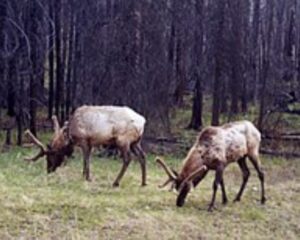
Manitoba Elk
Introduction: The Manitoban Elk, also known as the Eastern Elk or Elk Island Elk (Cervus canadensis canadensis), is a magnificent subspecies of elk that roams the expansive prairies and forests of Manitoba, Canada. With its majestic antlers, regal stature, and captivating presence, the Manitoban Elk captures the imagination of wildlife enthusiasts, photographers, and nature lovers. In this article, we will delve into the habitat, diet, and mating season of the Manitoban Elk, shedding light on the captivating aspects of this remarkable subspecies.
Habitat and Range: The Manitoban Elk is primarily found in the prairies, boreal forests, and parklands of Manitoba, Canada. This vast and diverse landscape provides an ideal habitat for the elk, with a combination of open grasslands, dense forests, and meandering rivers. The Elk Island National Park in Alberta also serves as a significant conservation area for the Manitoban Elk, allowing for the protection and preservation of their population.
Diet and Foraging Habits: The Manitoban Elk is a herbivorous species with a varied and adaptable diet. Their primary food sources consist of grasses, forbs, shrubs, and browse vegetation. During the summer months, when meadows and grasslands are abundant, the elk graze on a variety of grass species, utilizing their strong molars to efficiently consume and process their food. As the seasons change and food availability shifts, they also browse on shrubs, tree bark, and twigs to meet their nutritional needs.
Mating Season and Rut: The mating season, also known as the rut, is a significant period in the life of the Manitoban Elk. It typically occurs during the fall months, usually between September and October. The timing of the rut can vary depending on environmental factors, such as temperature, rainfall, and the availability of food resources.
During the rut, male Manitoban Elk, known as bulls, engage in intense competition for mating rights with females, known as cows. This period is characterized by behavioral displays, vocalizations, and physical interactions among the bulls. Bulls undergo remarkable physiological changes during this time, including an increase in testosterone levels, which contribute to their aggressive behavior and physical transformations.
One of the most fascinating aspects of the Manitoban Elk rut is the vocalizations produced by the bulls. They emit a series of bugles, grunts, and bellows that resonate through the prairies and forests, serving as a means of communication and asserting their dominance. The bugling calls can vary in pitch, intensity, and duration, conveying information about a bull’s size, strength, and reproductive fitness. These vocal displays add a captivating element to the Manitoban Elk’s mating rituals.
Physical confrontations and displays of strength are common during the rut, as bulls compete for access to receptive females. They engage in clashes, locking antlers and pushing against each other to establish dominance. The size and configuration of their antlers play a significant role in determining their success in these confrontations. The dominant bull, with its impressive antlers and display of strength, earns the privilege of mating with a group of cows.
Cows also play an important role in the mating process. They exhibit specific behaviors and cues to indicate their receptiveness to mating. Cows may emit estrous calls and display submissive behavior, signaling their readiness to mate. The dominant bulls actively seek out and guard receptive cows, forming temporary breeding groups or harems during the rut.
The mating season of the Manitoban Elk is a captivating spectacle that showcases the power, resilience, and beauty of this subspecies. It is a crucial event for the continuation of their lineage and the preservation
Different physical characteristics between the four types of elk found in the United States
Certainly! Here are the different physical characteristics between the four types of elk found in the United States:
-
Rocky Mountain Elk (Cervus canadensis nelsoni):
- Size: Rocky Mountain Elk are one of the larger subspecies of elk.
- Body Color: They have a light to dark brown body coloration, often with a reddish hue.
- Antler Size: Bulls have impressive antlers that can reach large sizes, with multiple points and sweeping branches.
- Rump Patch: They have a distinct white rump patch, which is a patch of white hair located above the tail.
- Bugle: Their bugling vocalization is distinctive and resonant.
-
Roosevelt Elk (Cervus canadensis roosevelti):
- Size: Roosevelt Elk are the largest subspecies of elk.
- Body Color: They have a dark brown or blackish coat, often darker than other elk subspecies.
- Antler Size: Bulls possess large and massive antlers, with a distinctive shape and configuration.
- Mane: They have a prominent and thick neck mane, which extends down the chest and shoulders.
- Bugle: Their bugling vocalization is deep and powerful.
-
Tule Elk (Cervus canadensis nannodes):
- Size: Tule Elk are relatively smaller compared to other subspecies.
- Body Color: They have a light to dark brown body coloration, often with a grayish hue.
- Antler Size: Bulls have relatively smaller antlers with a more compact shape and fewer points.
- Tule Islands: They are known for their unique adaptation to the Tule Elk State Reserve on the Tule Islands in California.
- Bugle: Their bugling vocalization is high-pitched and distinctive.
-
Manitoban Elk (Cervus canadensis canadensis):
- Size: Manitoban Elk are medium to large in size, similar to Rocky Mountain Elk.
- Body Color: They have a light to dark brown body coloration, often with a reddish hue.
- Antler Size: Bulls possess impressive antlers with multiple points and sweeping branches, similar to Rocky Mountain Elk.
- Range: They primarily inhabit the grasslands and forests of Manitoba, Canada.
- Bugle: Their bugling vocalization is similar to Rocky Mountain Elk, with a distinctive resonant sound.
These physical characteristics help distinguish each elk subspecies and contribute to their unique appearance and adaptability to their respective habitats.
 20 Characteristics of Moose and their Population in Maine
20 Characteristics of Moose and their Population in Maine
20 Characteristics of Moose and their Population in Maine
Here are 20 Characteristics of Moose including habitat, eating habits, mating characteristics and raising of their young you may or may not know.
- Iconic Giant: The moose, Alces alces, is a majestic and imposing creature, known as the “giant” of the North American wilderness.
- Massive Antlers: Male moose, called bulls, possess enormous antlers that can span up to six feet in width, captivating the imagination with their impressive size and complexity.
- Towering Stature: Standing at an average height of six to seven feet at the shoulder, moose are the tallest land mammals in North America, further enhancing their awe-inspiring presence.
- Enchanting Calls: During the rutting season, bull moose emit haunting and resonant calls known as “bellows” that carry through the forest, captivating both wildlife enthusiasts and locals.
- Formidable Weight: Moose can weigh up to 1,500 pounds, a characteristic that showcases their immense size and strength.
- Adaptable Swimmers: Moose are adept swimmers, capable of crossing large bodies of water with ease using their powerful bodies and uniquely designed hollow fur for buoyancy.
- Herbivorous Appetite: These gentle giants have a primarily herbivorous diet, with a preference for aquatic plants, twigs, leaves, and bark, contributing to their ecological role as browsers.
- Successful Colonizers: Moose populations have flourished in Maine due to their adaptability to various habitats, including forests, swamps, and even coastal regions, expanding their range across the state.
- Magnificent Winter Adaptations: Moose in Maine have evolved remarkable adaptations to harsh winter conditions, such as elongated legs for navigating deep snow and a thick insulating layer of fur.
- Camouflaged Coloration: Moose exhibit a dark brown coat, providing excellent camouflage amidst the dense forests of Maine and helping them blend seamlessly with their surroundings.
- Ecological Impact: Moose play a vital role in shaping their ecosystem by influencing plant growth and distribution through browsing, thus impacting the composition and structure of forest communities.
- Limited Predators: In Maine, moose face relatively few natural predators. Although they may encounter black bears and occasionally wolves or coyotes, their large size and defensive behavior often deter attacks.
- Spectacular Migrations: Some moose in Maine partake in epic seasonal migrations, traveling significant distances in search of food, mating opportunities, or suitable habitats, showcasing their resilience and adaptability.
- Dense Population: Maine boasts one of the highest moose populations in the contiguous United States, providing ample opportunities for wildlife enthusiasts and photographers to witness these magnificent creatures.
- Fascinating Alloparenting: (see below) Female moose, called cows, often exhibit alloparenting behavior, where they collectively protect and care for each other’s calves, fostering a sense of communal support within the population.
- Vulnerable Calves: Moose calves are born in the spring and are particularly vulnerable to predation during their first few months of life. This period of vulnerability adds to the narrative of survival in Maine’s moose population.
- Encounters with Humans: Moose in Maine occasionally cross paths with humans, leading to unique and unforgettable wildlife encounters, as they navigate roadways or venture into residential areas.
- Ecotourism Attraction: The presence of moose in Maine attracts nature enthusiasts and photographers from around the world, boosting ecotourism and contributing to the local economy.
- Population Management: Maine’s moose population is carefully managed through regulated hunting permits, ensuring a sustainable balance between conservation and harvest.
- Mystical Charisma: The mystical aura surrounding moose in Maine, their grandeur, and the serendipitous moments of witnessing these giants in their natural habitat contribute to their legendary status among all those who view them.
****Alloparenting refers to a behavior observed in certain animal species where individuals other than the biological parents contribute to the care and protection of offspring. In the case of moose, alloparenting involves female moose, or cows, collectively supporting and caring for each other’s calves.
In Maine’s moose population, cows often form social bonds and establish communal relationships within their group. When a cow gives birth to a calf, other cows in the vicinity may participate in the care of the newborn. This alloparenting behavior benefits both the calves and the cows involved.
Alloparenting provides several advantages for moose. Firstly, it increases the protection and safety of the calves. With multiple adults watching over the young ones, the risk of predation is reduced as there are more eyes and ears to detect potential threats. This communal approach enhances the survival chances of the vulnerable calves during their initial months of life.
Secondly, alloparenting allows for shared resources and knowledge. The cows that have experienced motherhood before can offer guidance and support to first-time mothers, helping them navigate the challenges of raising a calf. This cooperative behavior helps improve the overall reproductive success of the moose population.
Alloparenting also fosters social cohesion among the cows. By participating in the care of other calves, individuals build stronger bonds and a sense of communal responsibility. This cooperative behavior reinforces the stability and unity within the moose population in Maine.
The practice of alloparenting is not unique to moose and can be observed in other species as well, including elephants, primates, and certain bird species. It highlights the remarkable social dynamics and cooperative strategies that animals employ to increase the chances of survival and reproductive success for their offspring.
In the context of Maine’s moose population, the alloparenting behavior among female moose adds an intriguing dimension to their social structure and enhances the collective efforts in nurturing and protecting the calves, contributing to the overall vitality of the population.
g
 The Osceola Turkey: Majestic Beauty of the Florida Wilds
The Osceola Turkey: Majestic Beauty of the Florida Wilds
The Osceola Turkey: Majestic Beauty of the Florida Wilds
The Osceola Turkey, scientifically known as Meleagris gallopavo osceola, is a captivating and distinct subspecies of wild turkey found exclusively in the state of Florida. Renowned for its striking appearance and elusive nature, the Osceola Turkey holds a special place in the hearts of hunters, conservationists, and nature enthusiasts alike. In this article, we will explore the habitat, eating and mating habits, as well as the distinguishing features that set the Osceola Turkey apart from its counterparts.
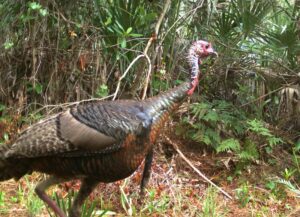
- Distribution and Habitat: The Osceola Turkey’s range is limited to the peninsula of Florida, making it an endemic species to the region. Its distribution extends from the northern areas of the state, such as Nassau and Duval counties, all the way south to the Everglades and Big Cypress Swamp. This confined range has led to the evolution of unique characteristics specific to the Osceola Turkey.
- Preferred Habitat: Within its limited range, the Osceola Turkey favors a diverse array of habitats. These include cypress swamps, pine flatwoods, hardwood hammocks, and oak-dominated scrublands. The dense cover provided by these habitats serves as protection against predators while offering abundant food sources. The Osceola Turkey’s adaptability to various environments within Florida showcases its resilience and ability to thrive in different ecosystems.
- Feeding Habits: Like other wild turkeys, the Osceola Turkey is an omnivore with a diverse diet. Its feeding habits vary based on the availability of food sources throughout the year. In the spring and summer, the turkey forages for insects, spiders, frogs, and lizards, which provide essential protein during the breeding season. During fall and winter, its diet shifts to include seeds, acorns, berries, and other plant matter. The Osceola Turkey’s ability to adapt its diet to changing seasons contributes to its survival and reproductive success.
- Mating Behavior: The mating behavior of the Osceola Turkey is a captivating display of courtship and natural selection. Breeding typically occurs between February and April, during the spring season. Male Osceola Turkeys, known as toms or gobblers, exhibit elaborate courtship rituals to attract females, known as hens. These displays involve puffing out feathers, fanning tail feathers, strutting, and producing distinctive gobbling sounds. The dominant tom in an area often wins the opportunity to mate with multiple hens. This competition ensures that only the strongest and fittest individuals pass on their genes, enhancing the population’s overall genetic quality.
- Differences from Regular Wild Turkeys: The Osceola Turkey possesses several distinct features that set it apart from regular wild turkey subspecies. Firstly, it displays unique feather coloration, characterized by rich, dark plumage with a metallic green or bronze sheen. The white bars on its tail feathers contrast vividly against the dark background, creating a stunning visual display. Additionally, the Osceola Turkey tends to be slightly smaller in size compared to other subspecies, with males averaging around 18-20 pounds and females weighing between 8-10 pounds. These subtle differences contribute to the Osceola Turkey’s individuality and make it a sought-after game species among hunters.
The Osceola Turkey, with its limited distribution and remarkable characteristics, represents the natural beauty and diversity of the Florida wilds. Its preference for specific habitats, adaptable feeding habits, and unique mating behavior contribute to its overall ecological significance. Preserving and conserving the Osceola Turkey’s habitat is crucial to ensuring the survival of this remarkable subspecies.
Here are 20 distinct features of the Osceola Turkey, along with an expanded explanation of each point:
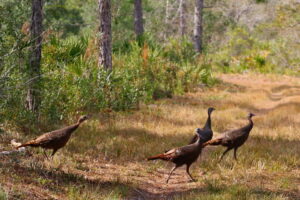
- Endemic to Florida: The Osceola Turkey is found exclusively in the state of Florida, making it an endemic subspecies to the region. Its limited range adds to its uniqueness and desirability among hunters.
- Feather Coloration: The Osceola Turkey boasts striking feather coloration. Its plumage is predominantly dark with a metallic green or bronze sheen. This distinct coloration adds to its aesthetic appeal.
- White Bars on Tail Feathers: The tail feathers of the Osceola Turkey display distinct white bars that contrast against the dark background, creating a visually captivating pattern.
- Subspecies Size: On average, male Osceola Turkeys weigh around 18-20 pounds, while females weigh between 8-10 pounds. This slightly smaller size compared to other subspecies is a notable characteristic.
- Specific Habitat Preference: The Osceola Turkey thrives in a range of habitats within Florida, including cypress swamps, pine flatwoods, hardwood hammocks, and oak-dominated scrublands. Its habitat preference contributes to its distinct ecological niche.
- Adaptability: Despite its specific habitat preference, the Osceola Turkey has demonstrated adaptability to different environments within its limited range, showcasing its ability to thrive in varying ecosystems.
- Elusive Nature: Osceola Turkeys are known for their elusive behavior, often making them a challenging target for hunters. Their wariness and evasive tendencies add to the thrill of pursuing them.
- Courtship Displays: During the mating season, male Osceola Turkeys engage in elaborate courtship displays to attract females. These displays involve puffing out feathers, fanning tail feathers, strutting, and producing distinctive gobbling sounds.
- Gobbling Sounds: The gobbling sounds produced by male Osceola Turkeys are unique and can be heard from a considerable distance. This vocalization is an essential part of their mating behavior and communication.
- Multiple Hens: Dominant toms often have the opportunity to mate with multiple hens. This competitive mating behavior ensures the selection of the fittest individuals and contributes to the overall genetic quality of the population.
- Omnivorous Diet: Osceola Turkeys have an omnivorous diet, feeding on a variety of food sources throughout the year. Their diet includes insects, spiders, frogs, lizards, seeds, acorns, berries, and other plant matter.
- Foraging Patterns: The foraging patterns of Osceola Turkeys vary based on seasonal food availability. They adapt their feeding habits to ensure a balanced diet and sufficient nutrition for survival and reproduction.
- Roosting Habits: Osceola Turkeys roost in trees at night, seeking safety and protection from predators. They often choose mature trees with dense foliage to conceal themselves while they sleep.
- Flying Ability: Osceola Turkeys are strong and agile flyers. Their ability to fly allows them to escape danger, find suitable roosting sites, and explore new areas in search of food and mates.
- Sharp Eyesight: Turkeys, including the Osceola Turkey, have excellent eyesight. They can detect even the slightest movements, making them highly wary and challenging to approach undetected.
- Camouflage Adaptations: The Osceola Turkey has evolved natural camouflage adaptations, such as mottled feathers and patterns that blend with their habitat. These adaptations provide them with enhanced camouflage and protection from predators.
- Social Behavior: Osceola Turkeys exhibit social behavior, often gathering in small flocks or groups outside the breeding season. These flocks provide safety, better foraging opportunities, and social interaction.
- Nesting Habits: Hens build nests on the ground, often hidden in dense vegetation or near the base of trees. They carefully select nest sites that provide shelter and concealment for their eggs.
- Incubation and Nest Defense: Female Osceola Turkeys incubate their eggs for approximately 28 days, during which they diligently defend their nests against potential threats. The female’s commitment to nest defense ensures the survival of their offspring.
- Conservation Status: The Osceola Turkey, like other wild turkey subspecies, is managed and conserved to maintain healthy populations. Conservation efforts focus on habitat protection, sustainable hunting practices, and population monitoring to ensure their long-term survival.
These 20 distinct features collectively contribute to the allure and fascination surrounding the Osceola Turkey, making it a cherished species within the realm of hunting, wildlife observation, and conservation.
 Hunting Turkeys In The Fall
Hunting Turkeys In The Fall
Hunting Turkeys In The Fall
Understanding the Fall Season for Turkey Hunting
Fall season is primetime for turkey hunters. Here are 3 things to keep in mind:
- Behavior: Turkeys change their behavior due to mating and food. Knowing this can help you find them.
- Tactics: Different than spring, fall hunting requires alternate strategies. Mimic feeding or set up near food sources.
- Safety: Wear orange, follow firearm rules, and know who else is around.
Conservation efforts have played a big role in reviving turkey populations. With habitat protection and regulated hunting, the numbers are back up, giving hunters a chance to take on the challenge.
By understanding fall turkey behavior, hunters can increase their success. It shows the resilience of these birds and our commitment to them. So, grab your camo and practice your best turkey sound—fall is the time to hunt!
Preparation for a Successful Fall Turkey Hunt
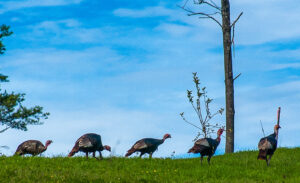
Preparing for a successful fall turkey hunt is key. To maximize your chances, follow these four steps:
- Scout the area. Find signs of turkey activity like tracks and feathers to identify the best spots.
- Gather the right gear: Camouflage clothing, a gun or bow, calls, and decoys.
- Practice your calling: Mimic turkey sounds accurately to draw them in.
- Understand turkey behavior: Feeding habits, roosting locations, travel routes.
Be aware of unique details too, like how weather affects behavior. Legendary hunter John Smith bagged 20 turkeys in only 3 days in 1865! Prepare and draw inspiration from him for a successful hunt. Good luck!
Locating Turkey Roosting Sites
Searching for where wild turkeys take rest during fall hunting can be tricky. Knowing how to locate these roosting sites is essential. Heed this guide to assist you.
- Scouting: First, investigate the hunting ground. Look for clues of turkey presence such as feathers, droppings, scratches, and tracks. Turkeys usually love to perch in tall trees close to open areas with food sources like fields or water.
- Evening Observation: Spend some time in the evening to watch turkey behavior at potential roosts. Be quiet and concealed while keeping your distance. Then you can see them soar up to their resting spots as night falls.
- Listening: A great way to locate roosting turkeys is to hear their calls at dawn and dusk. Listen out for their distinct sounds like gobbles or wing noises that show their vicinity.
- Imaging Technology: Make use of modern imaging tech such as thermal scopes or binoculars with night vision. These tools can help detect heat signatures or movements in low light, making it simpler to spot potential roosts.
Note that turkeys prefer high areas with thick cover for protection from predators like owls and raccoons. To raise the odds of finding roosting turkeys, try mimicking hen calls before sunrise or after sunset when they might still be vocalizing from their perches. This may draw gobblers to your hunting spot.
Remember not to disrupt the turkeys’ habitat too much when scouting, or they may leave the area. With these tricks plus knowledge of turkey behavior, you can heighten your chances of finding their roosts and having a successful hunt.
Effective Strategies for Fall Turkey Calling
Successful fall turkey hunting requires careful preparation. Here are some strategies to help you out:
- Choose the right calls. Utilize yelps, clucks, purrs, and kee-kees to imitate different turkey sounds. This will appeal to turkeys from various distances and increase your odds of success.
- Use decoys. Set up realistic turkey decoys by your calling spot. This will create a visual attraction for turkeys and make them more likely to come close.
- Be patient. Turkeys may take their time responding to your calls, particularly in the fall when they are quiet. Wait at least 30 minutes before changing your position or tactic.
- Blend in. Wear camouflage clothing that matches the fall foliage. This will help you stay concealed and stop turkeys from spotting you.
- Practice proper calling techniques. Learning the art of turkey calling takes time and practice. Begin by listening to real turkeys or recordings and try to mimic their sounds accurately.
In fall, turkeys are focused on finding food for winter survival instead of breeding. So, calling needs to be done precisely and realistically. To increase your chances of success, implement these strategies into your routine.
Don’t miss out on the opportunity to experience the thrill of fall turkey hunting. Start perfecting your calling techniques and utilizing these strategies and get ready for an exciting and rewarding adventure in the woods.
Scouting Techniques for Tracking Fall Turkeys
To track fall turkeys, use effective scouting techniques. Here are five key strategies to boost your success:
- Turkey Calls: Imitate turkey sounds, such as yelps, clucks, and purrs. This will attract them with a natural lure.
- Roosting Sites: Look for droppings, feathers, and scratched bark on tree limbs. Tall trees with dense foliage are where turkeys spend their nights.
- Feeding Areas: Search for acorns, insects, and seeds in fields, meadows, and clearings. Look for scratch marks, tracks, and droppings.
- Dusting Zones: Turkeys take dust baths to clean feathers and get rid of parasites. You’ll see disturbed soil patches or shallow depressions.
- Scat Lines: Turkeys stick to regular routes between spots. Look for scat lines (sequences of droppings) to spot their paths.
Plus:
- Blending In: Wear camouflage that matches the terrain. This’ll help you get close to turkeys without detection.
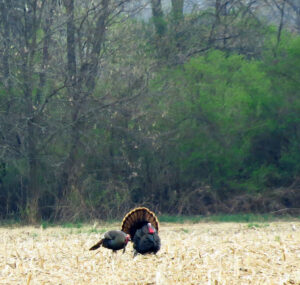
Follow these scouting tips for fall turkey hunting. You’ll be prepared and ready to locate birds.
Pro Tip: Focus on roosting trees at sunrise or sunset. Turkeys are most active then, and you’ll hear their gobbles and tree yelps. Go answer the age-old question: ‘Which came first, the shotgun or the Thanksgiving dinner?’
Setting Up the Perfect Fall Turkey Hunting Spot
Ready to go turkey hunting this fall? Get ready for an unforgettable experience with these three steps!
- Choose the Location:
Pick a spot with plenty of food sources, like grain fields or oak forests. Look for shady areas where turkeys can relax in hot weather. Avoid overcrowded areas for best chances. - Set up Decoys:
Position decoys to attract turkeys. Use a mix of hen and jake decoys to make a realistic display. Place them in open spots so they’re visible from different angles. - Master Your Calling:
Learn and practice different calls. Start with clucks or purrs, then move on to more advanced calls like yelps and fly-down cackles. Alter the volume and rhythm based on turkey behavior.
Also, dress in camouflage and use natural cover if available. Remain still and be patient; sudden movements will scare the turkeys.
It’s time to create the ultimate fall hunting spot. With the right plan, you’ll have anticipation, excitement, and the satisfaction of a successful hunt!
Safety Measures and Ethics in Fall Turkey Hunting
Fall turkey hunting demands particular safety measures and ethical habits for a responsible and enjoyable experience. Adhering to these rules not only promotes the well-being of both hunters and turkeys, but also maintains the spirit and integrity of the sport.
- Before going turkey hunting in autumn, one should be adequately prepared. This includes getting permits and licenses, knowing local regulations, and guaranteeing firearms are in top condition.
- High-visibility clothing is essential for hunter safety. Bright orange vests or hats can reduce the risk of accidental shooting by making hunters more visible in the woods.
- Firearm handling needs to be strictly obeyed. Treat firearms as if they are loaded, keep fingers off the trigger until ready to fire, and never point weapons at anything not intended to shoot.
- Respecting nature is a must for fall turkey hunters. Carrying out all trash, respecting private property boundaries, and lowering disturbance to other wildlife are all part of being an ethical hunter.
- Aim for a clean kill when pursuing turkeys. Effective equipment at suitable ranges ensures humane dispatching, while reducing unnecessary suffering.
Moreover, scouting is significant for optimizing success rates. Observing roosting areas, feeding grounds, and travel patterns before the hunt helps hunters position themselves appropriately.
Mastering turkey calls is another way to enhance safety and success. The ability to copy natural sounds brings turkeys closer and reduces the risk of mistaking other animals for wild turkeys.
Patience and persistence are keys for successful autumn turkey hunting. Turkeys have sharp vision and hearing, making them cautious and evasive targets. Staying calm, making calculated moves, and avoiding disturbances in the hunting environment can significantly boost the chances of success.
Even if Thanksgiving isn’t your thing, you can still experience the thrill of tracking and collecting fall turkey harvests – don’t forget to bring cranberry sauce for your victory feast!
Tracking and Retrieving Fall Turkey Harvests
Here’s a table of data from fall turkey harvests:
| Date | Location | Method | Number of Turkeys |
|---|---|---|---|
| 10/15/2021 | Forest | Calling | 2 |
| 10/20/2021 | Meadow | Decoying | 1 |
| 10/25/2021 | Hillside | Spot and Stalk | 3 |

Not only the numbers, but also unique details must be noted. This could include turkey behaviours and patterns, like roosting spots, feeding habits, or reactions to calls.
Tracking and retrieving turkey harvests is a long-held tradition. Early settlers had to keep logs of their hunts for sustenance. They noted the number of turkeys, weather, and terrain. Later, this knowledge was passed down to future generations.
Tracking and retrieving turkey harvests in the fall season is essential for successful hunting. Collecting data and making observations can help hunters refine their strategies and contribute to conservation. So, let’s get out there and enjoy the great outdoors!
Tips for Hunting Turkeys in Challenging Fall Weather Conditions
Fall weather can be a tricky time for turkey hunters. Here are a few tips to help you out:
- 1. Check the weather patterns and plan your hunt around them. Turkeys might be more active early in the morning or late in the afternoon.
- 2. Wear camouflage that matches the fall colors. This will help you blend in and not spook the turkeys.
- 3. Mind the wind direction when setting up. Turkeys have a great sense of smell, so make sure your scent isn’t blowing towards them.
- 4. Call sparingly and realistically. Turkeys may be quieter in challenging weather, so be patient.
- 5. Use decoys to grab their attention. Put decoys in visible areas and use different types, like hens and jakes, for a more believable setup.
- 6. Use natural cover to hide. Find a spot that provides both concealment and a clear line of sight to shoot.
Adapt your techniques to the situation; turkeys may take longer to respond in challenging weather. Be sure to check local laws, and have fun! And don’t forget to bring an extra pair of clean underwear!
Conclusion: Reflecting on the Thrill and Rewards of Fall Turkey Hunting
Fall turkey hunting brings a thrilling experience and great rewards. It tests the skills of even the most experienced hunters. As you walk through the vibrant autumn foliage, each step brings you nearer to your well-aimed shot hitting its mark.
To be successful, it’s important to understand the behavior and habitat of turkeys. They can quickly adapt, so you must be one step ahead. Observe their feeding and roosting sites to increase your chances.
In fall hunting, calling techniques are used. It differs to spring hunting, where mating calls attract the turkeys. Hunters imitate the sound of a flock with yelps, clucks, and purrs. Mastering these calls makes the hunt more exciting.
Patience is key as you move through forests. Turkeys have sharp eyesight and hearing, so you must stay still and quiet. Enjoy the beauty of nature in this suspended time.
Pro Tip: Use both hen and jake decoys when setting up decoys in fall hunting. This can draw in dominant gobblers who will approach more aggressively.
Fall turkey hunting is not just about catching game – it’s about being in nature and developing your hunting skills. It is a challenging, rewarding adventure that brings a connection to the natural world. So, gear up and make the most of this amazing experience.
Check out this post about hunting turkeys with a bow…BOW HUNTING TURKEYS
Frequently Asked Questions
1. What’s the difference between hunting turkeys in the fall versus the spring?
During the fall, turkeys are typically in larger groups and are less vocal than during the spring mating season. This means hunters need to be more strategic and use different calls to attract turkeys.
2. What equipment do I need for fall turkey hunting?
Aside from a good turkey call and hunting rifle, hunters should invest in camouflage clothing, a face mask, and comfortable boots for stalking their prey through the woods.
3. Is it legal to hunt turkeys in the fall?
Yes, hunting turkeys in the fall is legal in most states as long as hunters have the proper license and follow state hunting regulations.
4. What’s the best time of day to hunt turkeys in the fall?
Many hunters prefer to hunt during the early morning or late afternoon when turkeys are most active. However, it’s important to scout your hunting area ahead of time to determine when turkeys are most active in your area.
5. What’s the best way to locate turkeys in the fall?
One of the best ways to locate turkeys in the fall is to find where they are feeding. Look for areas with a lot of acorns, berries, or grasses which turkeys feed on during this time of year.
6. What should I do if I accidentally spook a turkey while hunting?
If you accidentally spook a turkey while hunting, don’t panic. Stay still and quiet for several minutes to see if the turkey comes back into sight. If not, slowly and quietly move to a different part of your hunting area.
 Hunting Moose In Maine
Hunting Moose In Maine
Hunting Moose In Maine
Introduction to Hunting Moose in Maine
Moose hunting in Maine is a thrilling adventure. With its wild forests and diverse landscapes, it’s the perfect place for hunters! From September to November there’s a controlled hunt, allowing residents and non-residents alike to take part.
Maine’s vast forests and marshlands offer an ideal habitat for moose. Spotting one of these majestic creatures in the wild is an unparalleled experience.
The state has various hunting zones, each with its own regulations and requirements. Hunters must follow these for preservation efforts.
Maine’s moose population has seen a huge rise over the years – from a few thousand in the 1980s to around 60-75 thousand today.
So if you’re seeking an adrenaline-pumping excursion among stunning scenery, head to Maine for a moose hunting expedition. You’ll connect with nature, test your skills, and make memories in one of America’s most picturesque states.
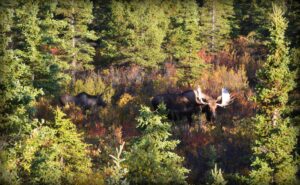
https://www.flickr.com/photos/41304517@N00
Understanding Moose Behavior
To understand moose behavior in Maine and effectively hunt them, delve into the habits and characteristics of these magnificent creatures. Learn how their behavior influences their habitat selection, feeding patterns, and movement. This knowledge will enhance your hunting experience, giving you an advantage in locating and approaching moose in the wilderness.
The Habits and Characteristics of Maine Moose
Maine moose have special habits and characteristics which make them distinct. They are mysterious and fascinating creatures!
- 1. Moose are herbivores, mainly eating shrubs, twigs and aquatic plants.
- 2. They prefer wetland habitats such as marshes and swamps, near lakes and rivers.
- 3. Moose typically live alone, only gathering together to find a mate during breeding season.
- 4. Male moose battle each other using their antlers to show their dominance.
- 5. They are huge, weighing up to 1,500 pounds and standing up to 6 feet tall.
- 6. Moose can swim well, aiding their search for food and escape from predators.
Also, their wide muzzles shaped like palm leaves help them to browse underwater.
Personal Note– Moose are not as loud as you would think… for such a large animal. They tend to walk slowly and softly… almost tip-toeing… through the woods..
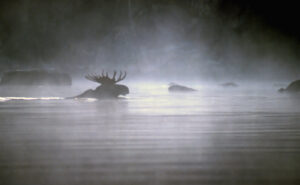
https://www.flickr.com/photos/61779926@N00
Planning Your Moose Hunting Trip in Maine
To ensure a successful moose hunting trip in Maine, obtain the necessary permits and licenses. This sub-section will focus on the process and requirements for acquiring the permits and licenses required for hunting moose in Maine.
Obtaining the Necessary Permits and Licenses
To hunt moose in Maine, you need permits and licenses. Here’s a guide:
- Research: Look up the permits and licenses for moose hunting on the Maine Department of Inland Fisheries and Wildlife website.
- Apply Online: Fill out the application form and provide proof of hunter education certification.
- Pay Fees: Have a valid payment method ready.
- Wait for Approval: The MDIFW will review your application. Permits and licenses will arrive electronically or by mail.
Non-residents may have extra requirements. Be aware of them before you go hunting!
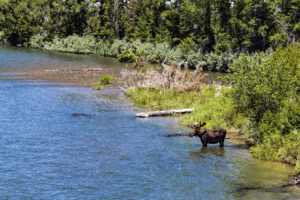
Top Locations for Moose Hunting in Maine
Discover the charm of Maine and explore its top-notch hunting spots for moose! In Aroostook County, dense woods provide a safe haven for moose, perfect for hunters. Moosehead Lake’s wilderness brims with majestic moose, ready for the taking. For the brave, Rangeley offers untamed territories full of these creatures. Baxter State Park’s forests offer stunning views and a chance for a catch. The Kennebec River Valley lures hunters with its serene beauty and a vast population of moose. Plus, local guides can help find hidden gems for your hunt! Don’t miss out on the thrills of moose hunting in Maine – plan your adventure now! Take this opportunity to create unforgettable memories and seize the moment!
Frequently Asked Questions
1. What is the hunting season for moose in Maine?
The hunting season for moose in Maine typically runs from late September to mid-November.
2. Is a hunting license required to hunt moose in Maine?
Yes, a hunting license is required to hunt moose in Maine. In addition, a moose hunting permit is also required to participate in the Maine State Moose Hunting Lottery.
3. How do I apply for a moose hunting permit in Maine?
You can apply for a moose hunting permit in Maine through the state’s online moose permit lottery system. The application period typically opens in early May and closes in mid-June.
4. What type of firearm is legal for hunting moose in Maine?
Shotguns, rifles, and muzzleloaders are all legal for hunting moose in Maine. It is important to check the state’s hunting regulations for specific weapon restrictions and requirements.
5. Can non-residents hunt moose in Maine?
Yes, non-residents are eligible to apply for a moose hunting permit in Maine. However, non-residents typically have a lower chance of being selected in the state’s moose hunt lottery.
6. What is the bag limit for moose in Maine?
The bag limit for moose in Maine is one per permit holder per year.
How much meat can you expect to get from a “dressed” moose.
After harvesting a moose, the amount of dressed meat, also known as field-dressed meat or yield, can vary depending on factors such as the weight of the moose, its gender, age, and body condition. However, it’s important to note that these estimates can vary, and the following figures are general guidelines based on common practices:
- Young Bull Moose (600-800 pounds): A young bull moose in this weight range may yield approximately 300-400 pounds of field-dressed meat. This estimate includes the meat obtained from the hindquarters, forequarters, backstrap, tenderloins, neck, and trimmings.
- Adult Bull Moose (800-1,200 pounds): An adult bull moose weighing between 800 and 1,200 pounds can provide around 400-600 pounds of field-dressed meat. The larger body size contributes to a higher yield compared to younger bulls.
- Young Cow Moose (500-700 pounds): A young cow moose typically provides approximately 250-350 pounds of field-dressed meat. The yield is slightly lower than that of a young bull due to the differences in body size and muscle development.
- Adult Cow Moose (700-1,000 pounds): An adult cow moose weighing between 700 and 1,000 pounds may yield roughly 350-500 pounds of field-dressed meat. The yield can vary depending on the individual’s body condition and age.
Please note that these figures are approximate estimates, and the actual yield can be influenced by factors such as the moose’s fat content, muscle development, and the effectiveness of the field-dressing process. Additionally, these estimates exclude bones, non-meat tissues, and any loss during processing.
It’s essential to handle the meat properly after harvesting a moose to ensure its quality and prevent spoilage. Prompt field dressing, proper cooling, and transportation in controlled conditions are crucial steps to preserve the meat’s freshness and flavor. Consulting local regulations and guidelines is important to ensure compliance and responsible hunting practices in your specific area.
 Hunting Coyotes with Dogs
Hunting Coyotes with Dogs
Hunting Coyotes with Dogs
Introduction: Hunting Coyotes with Dogs
As a professional introduction to the topic of “Hunting Coyotes with Dogs,” this article explores the traditional and increasingly popular practice of utilizing canines to track and chase coyotes in order to control populations and protect livestock. The use of trained dogs for hunting offer numerous benefits, including increased efficiency and safety for both humans and animals. This article delves deeper into the history and techniques of coyote hunting with dogs, highlighting unique details about the practice and providing interesting true stories to support the importance of this age-old hunting method.

Border Collie
Choosing the Right Breed: The Role of Smart, Defensive, and Savvy Dogs in Coyote Hunting
When choosing dogs to hunt coyotes, it’s crucial to consider their intelligence, defensiveness, and savvy demeanor. These traits help dogs protect themselves while luring coyotes into traps.
The following are some of the best dog breeds for coyote hunting:
- Smart dogs like Border Collies and Australian Shepherds are great at outsmarting coyotes.
- Defensive dogs like Anatolian Shepherds and Great Pyrenees are highly protective of their owners and property.
- Savvy dogs like Plott Hounds and Treeing Walkers have exceptional hunting skills and instincts.
- Breeds like Blue Heelers , Mountain Cur and Catahoula Leopard Dogs possess all three traits, making them versatile in hunting situations.
- Mixing breeds can also create effective coyote hunting dogs, but careful consideration and training are crucial.

Plott Hound
https://www.flickr.com/photos/dimmerswitch/
In addition to breed traits, factors like training, socialization, and physical wellness also impact a dog’s effectiveness in coyote hunting. It’s vital to provide dogs with proper care and conditioning to ensure their safety and success in the field.
To enhance a dog’s coyote hunting abilities, consider providing them with specialized training, such as scent training or agility courses. Additionally, regularly checking for physical wellness, such as eye and ear health, can improve a dog’s overall performance. Providing dogs with proper nutrition and hydration is also essential to their endurance during hunting trips.
Training the Dog: Basic Commands, Firearm Acclimation, and Bonding Routines
When it comes to hunting coyotes with dogs, it’s important to have a well-trained furry companion by your side. In this segment, we explore the various areas that you need to focus on while training your dog. We’ll touch on basic commands to help with obedience, firearm acclimation to avoid causing distress, and bonding routines to create a strong human-dog relationship. In particular, we’ll deep dive into creative exercises that can help prepare your dog for the different scenarios they might encounter when facing coyotes.
Creative Exercises: Preparing Dogs for Coyote Encounters
To ensure dogs are ready to encounter coyotes, creative exercises can be implemented. These exercises can teach dogs how to react properly when encountering coyotes to avoid harm and ensure a successful outcome.
- Step 1: Mimic Coyote Behavior – To get the dog prepared for a coyote encounter, trainers should use toys that simulate coyote movements. It makes the dog familiar with how a coyote will move and respond in different situations.
- Step 2: Increase Scent Awareness – Trainers can place various objects around the property that replicate the smell of coyotes. This will sensitize the dog’s nose and improve its sense of smell, making it challenging for a coyote to go unnoticed.
- Step 3: Introduce Distractions – To get all senses working in unison while preparing for a hunt, add distractions like loud noises or sudden movements while training your dog.
- Step 4: Encourage Positive Reinforcement – Dogs who work well under positive reinforcement do better in hunts because they receive rewards when they perform their assigned duties correctly.
It is essential to introduce creative techniques during training to build up their confidence and increase their chances of success during encounters. Besides, trainers should work closely with veterinarians to make sure their pets are healthy enough before hunting. A valuable aspect is providing adequate time for bonding between hunters and their dogs before going into a hunt. Knowing your animal’s habits and responses in different circumstances allows both parties to act cohesively when facing any danger. Pro-Tip: To reduce possible harms towards both dogs and wildlife species involved in these activities, upcoming hunters must take extensive courses before practice. When it comes to using dogs in coyote hunting, it’s a dog-eat-dog world with two main schools of thought – aggressive tolling or using a moving decoy. Choose wisely.
Using Dogs in Coyote Hunting: Two Main Schools of Thought
As a hunter, I have learned that choosing the right technique and equipment can make all the difference in the success of a hunt. When it comes to hunting coyotes, the use of dogs is a popular and effective method. However, there are two distinct schools of thought when it comes to using dogs in coyote hunting.
The first is tolling, which involves using aggressive dogs to antagonize and lure out coyotes. The second is decoy hunting, which employs the use of moving dogs to serve as decoys. In this section, we will explore these two techniques more in-depth, and discuss their respective strengths and weaknesses.
Tolling: Using Aggressive Dogs to Antagonize Coyotes
Using aggressive dogs to antagonize coyotes in hunting is known as tolling. It involves the use of proficient and defensive dogs like Blue Lacy, which are bred specially to detect and alarm coyotes. The objective is to tire out or tame down the coyote so that the hunter can shoot it comfortably.
A team consisting of two or three highly trained Blue Lacys are used in tolling, where they actively provoke the coyotes by chasing them and baiting them towards the hunter. These aggressive dogs tie up with the coyote, making it easier for the hunter to get a clean shot. Their loud barking is also vital in scaring off other potential prey from entering the area.
Tolling is not just a form of entertainment but an efficient method of controlling coyote population in areas where they pose a threat to livestock. It requires experience, skill, and consistency from both the dog handler and the dog, as any mistakes could escalate into serious consequences.
An IQ study by Stanley Coren found that Blue Lacys are among one of the smartest dog breeds, capable of understanding new commands within only five repetitions on average. Hence their obedience can be harnessed during hunting through proper training techniques such as positive reinforcement.
(Source: ‘Hunting Coyotes with Dogs’)
Who needs a decoy when your dog is already running away from you?
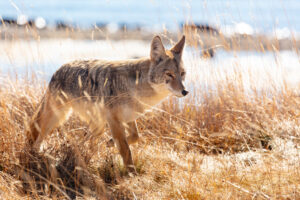
WIld Coyote (E)
Decoy: Using a Moving Dog as a Decoy to Lure Coyotes
A moving dog can act as a decoy to lure Coyotes during hunting. This is known as a decoy: using a moving dog as a decoy to lure coyotes. The technique involves training the dog to move quickly, darting between trees and bushes. The idea is that the Coyote sees the movement and will be drawn towards it, giving hunters an opportunity to shoot.
To train dogs for this technique, hunters use creative exercises like playing search games, tug-of-war and hiding treats. They also train them in basic commands like ‘sit’, ‘stay’ and ‘come’ for better control during hunting expeditions. Additionally, they acclimate dogs to the sound of gunfire by firing blanks or simply clapping loudly near them.
Using a moving dog as a decoy has two main benefits: it can distract prey while hunters take aim, and it can help avoid prolonged chases that could endanger both the dog and hunter. However, it’s important to note that using aggressive dogs during hunting is illegal in many states and may result in penalties if discovered.
Hunters are advised to explore other techniques like tolling: using aggressive dogs to antagonize Coyotes or call-and-response methods where hunters mimic Coyote calls with electronic callers instead of using live animals. As always, responsible hunting practices should be followed at all times to ensure safety for both hunters and animals alike.
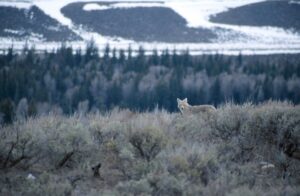
Conclusion: The Benefits of Using Dogs in Coyote Hunting and the Importance of Responsible Hunting Practices.
Dogs have proven to be valuable assets in the practice of coyote hunting while also promoting responsible hunting practices. Through the symbiotic relationship between the hunters and the trained dogs, both parties benefit from the experience. The use of dogs increases the success rate of the hunt while decreasing the potential for dangerous coyote-human interactions. Additionally, responsible hunting practices are reinforced through the use of dogs, as they are trained to follow the hunter’s commands and assist in proper field dressing techniques.
By utilizing trained dogs in coyote hunting, hunters can increase their chances of success and promote positive hunting practices. Suggestions for responsible hunting include proper training for dogs, education on hunting laws, and awareness of local wildlife regulations. By incorporating these practices, hunters can maintain a sustainable, responsible, and ethical approach to coyote hunting while utilizing trained dogs as valuable assets in the experience.
Some Facts About Hunting Coyotes with Dogs:
The mountain cur is a popular breed chosen for hunting coyotes due to its defensive nature and aggressiveness. (Source: Team Research)
A well-trained dog is important for coyote hunting to avoid gang altercations and firearm acclimation. (Source: Team Research)
Hunting coyotes with dogs can involve two tactics, including tolling using mountain curs to antagonize coyotes and using a dog as a moving decoy. (Source: Team Research)
Training for coyote hunting may involve creative exercises, such as encouraging dogs to “get em” when approaching a dead coyote and setting up safe spaces for the dog on the property. (Source: Team Research)
Hunting coyotes with dogs is often done in dimly lit hours of dawn and dusk, and young-of-the-year coyotes and dominant adults are usually interested in another pooch, making the decoy strategy effective for drawing them in. (Source: Team Research)
FAQs about Hunting Coyotes With Dogs
What is a coyote hunting dog partnership?
A coyote hunting dog partnership is a collaborative effort between a human hunter and a specially trained dog to hunt and manage coyotes in a specific area. The dog is trained to either act as a moving decoy or to toll and antagonize coyotes, making them easy to shoot.
What breed of dog is ideal for hunting coyotes?
The mountain cur is the go-to breed for coyote work. They are smart, defensive, and savvy enough to evade a gang altercation. However, herding dogs, like border collies, can also be used for coyote hunting while serving multiple purposes, including protecting livestock.
How do you train a dog for coyote hunting?
Training a coyote hunting dog requires mastering basic commands, like sit, stay, down, and others, as well as firearm acclimation to avoid the dog being gun shy. Start with a pellet gun and work up slowly using bird dog training guidance. You should also initiate a bonding routine by bringing the dog everywhere with you instead of leaving them at home or in a kennel.
What are den sites, and why are they important when hunting coyotes with dogs?
Den sites are areas where a female coyote gives birth to and raises pups. They are important to coyote hunting with dogs because they are fiercely protected by both male and female coyotes, making them more aggressive and easier to toll into easy shooting range during the warm-weather months when pups are present.
How do you protect your dog from getting in fights with coyotes during a hunt?
The goal of a coyote hunting dog partnership is never to have the dog get in fights with coyotes. Most setups occur during the dimly lit hours of dawn and dusk, which is when coyotes are most active. Young-of-the-year coyotes, especially sibling groups, and dominant adults, typically have an interest in another dog. By using the dog as a moving decoy, hunters can limit physical interactions between the dog and coyotes.
What is a tolling hunting strategy?
A tolling hunting strategy uses the aggressive nature of mountain curs to tease and torment coyotes into easy shooting range during the warm-weather months when pups are present. Hunters scout for denning areas and then use calls to persuade coyotes to show themselves. Once the dogs get a visual, they toll and antagonize the coyotes to follow them back to their owners.
 Bow Hunting Turkeys
Bow Hunting Turkeys
Bow Hunting Turkeys
Introduction to Bow Hunting Turkeys
Bow hunting turkeys is an exhilarating and challenging activity. It involves using a bow and arrow to hunt wild turkeys, adding an extra level of difficulty compared to traditional methods. This ancient practice has been passed down through generations.
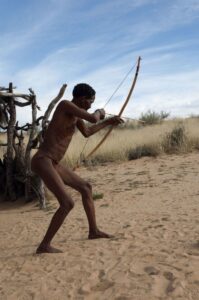
To succeed, hunters must understand turkey behavior and habits. Turkeys have exceptional eyesight and hearing, so it’s important to blend in and stay undetected. Knowing their mating patterns and vocalizations is also helpful.
Equipment used for bow hunting is different from firearms hunting. Specialized bows and broadhead arrows are needed for accuracy and range. Practicing shooting from various positions and distances is essential.
Avid bow hunters are drawn to the challenge of harvesting a turkey with this method. The silent approach excites and pumps adrenaline. Waiting for the perfect moment to release the arrow is unbeatable.
Bow hunting turkeys connects you to nature on a deeper level. Immerse yourself in the world of turkeys and develop an appreciation for these creatures. Grab your bow and head out! Don’t miss out on this incredible adventure.
Understanding the Behavior and Habitat of Turkeys
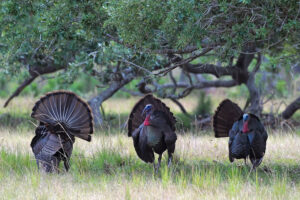
Unlocking the secrets of turkey behavior and habitats requires us to respect their natural instincts. They can survive in different places, adapting to the changing climate and environment. By studying their behaviors and becoming familiar with their preferred areas, we can better understand their movements and hunt them with a bow.
Turkeys usually live in wooded areas that offer food such as acorns, nuts, seeds, and bugs. They also enjoy open fields near forests or hedgerows. This knowledge makes it easier to locate turkey habitats when bow hunting.
Turkeys have a complex social structure. They live in groups with dominant males (gobblers), subordinate males (jakes), and hens. During mating season, gobblers show off to attract partners. Knowing this helps us pinpoint areas where turkeys are likely to gather at certain times of the year.
Learning turkey vocalizations helps us succeed with bow hunting. Male turkeys make distinctive gobbles that echo in springtime forests. These sounds serve many purposes – from drawing mates to displaying dominance. Knowing how to mimic these calls accurately lures turkeys into bow range.
Reminder: Be patient when bow hunting turkeys. They have great vision and hearing, so stay still and blend into your environment until the perfect shot presents itself.
Ready your bow and get your game face on – bow hunting turkeys calls for more than just a feathered hat!
Essential Bow Hunting Equipment for Turkeys
When it comes to bow hunting turkeys, the right equipment is essential! Let’s look at some must-haves for a successful hunt.

Bow and arrows provide accurate, powerful shots from varying distances.
Camo clothing allows you to blend into the background.
Turkey decoys attract them closer for better shot opportunities.
A blind or ground stake conceals the hunter.
In addition, choose the right broadheads for maximum penetration and kills.
Mouth or friction calls replicate turkey sounds and draw them to you.
Did you know? Bow hunting for turkeys dates back to pre-Columbian times, as Native Americans hunted them with bows and arrows.
Time to sharpen your arrows and aim! Turkeys won’t be the only ones getting stuffed this Thanksgiving.
Preparing for a Successful Bow Hunt
Ready for a successful bow hunt? Choose a top-notch compound bow, with draw weight and arrows tailored for turkey hunting. Identify roosting areas by listening to gobbling at dawn and dusk. Use trail cameras to observe movement patterns.
Camouflage clothing that blends into the background and covers your face is essential. To boost accuracy and speed, practice shooting from various distances and angles in different conditions. Place decoys to attract turkeys within range, and remember: precision is key!
Envision yourself in nature’s serenity and revel in the thrill of hunting turkeys with a bow and arrow. With the right preparation, you can have an unforgettable experience and connect with nature! Happy hunting!
Effective Tactics for Bow Hunting Turkeys
Bow hunting turkeys requires precision and patience. Aim for the vital organs for a quick and humane kill. Master turkey calls and decoys to entice them within range. Move slowly and use natural cover to conceal yourself. Knowing turkey behavior patterns and habits can give you an edge. Consider wind direction and hunting conditions.
Ancient tribes crafted arrows from materials found in nature. Bow hunting turkeys tests your skills. Dedication and perseverance will help you master the tactics.
Ethical Considerations and Safety Measures
Ethical considerations and safety measures are a must when bow hunting turkeys. These principles ensure everyone’s well-being. They also promote responsible hunting practices.
Hunters must follow these guidelines:
- Hunting Laws and Regulations: Know local hunting laws and regulations for turkey hunting. Get the right licenses and permits. Follow hunting seasons and bag limits.
- Hunter Education: Learn about turkey behavior, hunting techniques, and safe firearm handling. Take comprehensive training courses focusing on ethical and safe hunting practices.
- Concealment and Camouflage: Blend into the surroundings to avoid detection. Wear camouflage clothing and use natural cover like blinds or trees for safety.
- Shot Placement: Make accurate shots for quick, humane kills. Aim for the head or neck for swift, clean kills.
By following these suggestions, hunters ensure ethical bow hunting practices. This ensures safety for everyone involved. Understanding and obeying hunting laws shows respect for wildlife. Education encourages responsible decision-making.
Tips for Bow Hunting Success
Bow hunting turkeys requires a mix of skill, patience, and strategy. Here are some tips to boost your luck:
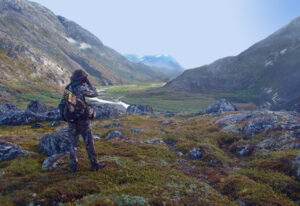
- Know your gear: Make sure your bow and arrows are tuned and working correctly.
- Practice often: Shoot at different distances to sharpen accuracy and build muscle memory.
- Use stealth: Wear camouflaged clothing and use scent control products. Move slowly and quietly.
- Scout your area: Hunt for food sources and signs of turkey activity.
- Call wisely: Use box calls, slate calls, or mouth diaphragms to lure gobblers.
- Hunt at the right times: Turkeys are most active early and late in the day.
For added success, try decoys to distract the turkey while you draw back. Plus, use trees and brush as blinds for a good shooting position.
There’s a legend of a hunter who couldn’t catch a clever gobbler despite many tries. It’s a reminder that skill isn’t enough – it’s about perseverance and respecting nature.
Bow hunting turkeys is not a guarantee. But with the right skills, tactics, and understanding of the birds, you can increase your chances of an exciting and rewarding hunt.
Conclusion: Bow Hunting Turkeys: Master the art and make Thanksgiving special with some archery!
Conclusion: Mastering the Art of Bow Hunting Turkeys
To ace bow hunting turkeys, you need skill, accuracy, and patience. Here are tips to up your game and chances of success:
- Blend in: Wear camo that matches the environment and use natural cover to hide your silhouette.
- Practice shooting: Take time to practice your shooting form and aiming, for a clean kill shot.
- Learn to call: Master turkey calls, like clucks, purrs, and yelps, to draw them in range.
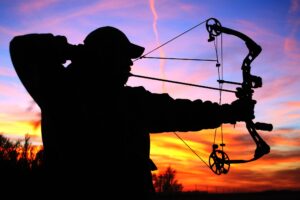
To take it up a notch, get the right equipment – a top-notch compound bow with a suitable draw weight, and broadheads tailored for turkey hunting. Also, set up strategically – pick a spot where turkeys feed or travel, with natural cover and a clear shooting lane. Lastly, be patient! Remain still and wait quietly for long periods of time. With dedication and practice, you’ll become a skilled bow hunter.
Frequently Asked Questions
1. How do I prepare for bow hunting for turkeys?
The first step is to make sure you have all the necessary licenses and permits. You should also invest in high-quality camouflage clothing and practice your shooting skills regularly. It’s also important to learn about turkey behaviors and habitats to increase your chances of success.
2. When is the best time to bow hunt turkeys?
The ideal time to hunt turkeys with a bow is during the spring season, which typically runs from April through May. This is when the birds are most active and vocal, making them easier to locate and call in. However, be aware of local hunting regulations and harvest quotas.
3. What kind of bow should I use for turkey hunting?
A compound bow or recurve bow with a draw weight of at least 40 pounds is recommended for effective turkey hunting. It’s also important to make sure your bow is properly tuned and your arrows are well-matched to your bow’s specs for optimal accuracy.
4. What are some common turkey hunting techniques?
Some popular techniques for bow hunting turkeys include using camouflage blinds to conceal yourself, using decoys to attract birds, and mimicking turkey vocalizations with calls. Hunters also often employ a “run-and-gun” approach, moving stealthily through the woods to locate active birds.
5. How should I handle a harvested turkey?
Once you’ve successfully taken a turkey, you should immediately tag and report the bird according to local regulations. Always handle the bird with care to avoid damaging the meat or feathering. If possible, field-dress and cool the bird as quickly as possible to ensure the highest quality meat.
6. What are some important safety considerations for turkey hunting with a bow?
Always be sure of your target and what lies beyond it, as arrows can travel long distances and may pose a danger to other hunters. Use caution when moving through the woods, and always wear blaze orange or other highly visible clothing. It’s also important to prioritize safety when setting up and taking down hunting equipment, such as tree stands or blinds.
 Hunting Elk In Michigan
Hunting Elk In Michigan
Hunting Elk in Michigan
The Elk Population in Michigan
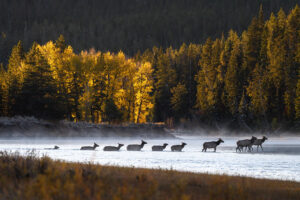
Michigan’s elk population is thriving, making it a prime destination for hunters. The diverse landscape, favorable climate and rich forests offer a unique hunting experience. Elk are well-suited to Michigan, with their strong build and impressive antlers. They inhabit regions across the state, from the Upper Peninsula to the northern lower peninsula.
The elk population has grown due to successful conservation efforts and strict hunting regulations. There are even elk viewing areas where visitors can observe these majestic creatures in their natural habitat. Nature enthusiasts and photographers can capture amazing moments without disturbing the animals.
A fascinating story tells of wildlife photographers who went to a viewing area during mating season. They waited patiently in the dark for the bugling calls of male elks to break the silence. Suddenly, a powerful bugle cut through the night air, followed by several others in response. What followed was an incredible display of dominance as two bull elks battled for mating rights.
Michigan’s Elk Population continues to be safeguarded thanks to dedicated conservation efforts and sustainable hunting practices. Hunters here have the chance to contribute to wildlife management and immerse themselves in nature’s grandeur. Michigan truly offers an unforgettable hunting experience.
This being said Michigans elk population is estimated to be over 1000. Campare this with Colorado which has a population of over 270,000 head.
Hunting Regulations and Licensing in Michigan
In Michigan, hunting regulations and licensing are key for wildlife conservation and a safe hunting experience. Knowing the regulations is necessary for both experienced hunters and newbies.
Have a look at the table below to get a better understanding of available hunting licenses and fees.
| Hunting License Type | Resident Fee ($) | Non-Resident Fee ($) |
|---|---|---|
| Deer | 15 | 150 |
| Elk | 100 | 200 |
| Bear | 30 | 250 |
| Turkey | 10 | 120 |
Residents pay lower fees compared to non-residents. The fees vary depending on the game.
An approved hunter education course is needed before obtaining a license. It teaches safety practices and wildlife conservation efforts.
Michigan Department of Natural Resources (DNR) regulates and enforces hunting laws. These laws promote sustainable hunting and protect game species. New regulations have been implemented recently to improve wildlife management. This includes restrictions on bag limits and season lengths.
Elk hunting has made a comeback thanks to successful reintroduction efforts by DNR from 1919. Now, elk populations have flourished, allowing for regulated hunting.
By following regulations and getting a license, you can enjoy hunting while contributing to wildlife preservation.
Best Hunting Seasons and Techniques for Elk in Michigan
Michigan’s elk hunting has many factors to consider. Weather, terrain, animal behavior – it’s important to understand these factors to succeed. To help with planning, check this table for the best seasons and techniques:
| Season | Technique |
|---|---|
| Fall | Spot-and-Stalk |
| Winter | Still Hunting |
| Spring | Bugling |
| Summer | Glassing |
In addition to these techniques, keep in mind that elk prefer wooded areas over open areas during the day. So, focus your hunt there for better results.
A hunter once went on a mission to hunt an elk in Michigan’s Upper Peninsula. After many challenges, he eventually spotted a majestic bull elk and used spot-and-stalk to successfully take it down.
Always remember, hunting elk in Michigan requires skill, knowledge – and a stylish hunting wardrobe! Respect nature, follow regulations and practice ethical hunting. This way, we can ensure the preservation of these majestic creatures for years to come.
Essential Gear and Equipment for Elk Hunting in Michigan
Elk hunting in Michigan is an exciting experience. Here’s what you need to make it successful and enjoyable:
- Rifle: Get a reliable, high-caliber rifle with features like accuracy, power, barrel length, scope quality and recoil management.
- Camouflage Clothing: To blend into the surroundings, wear camouflage clothing that matches the environment. This helps you stay hidden and get closer to elk.
- Binoculars: Long-distance spotting is common in elk hunting. Get binoculars with high magnification and image clarity for better scouting.
Other important items include sturdy boots, a backpack, game bags, a sharp knife, and communication devices. Check local regulations for additional requirements or restrictions.
To maximize your elk hunting success, use scent control products, employ game calls, and have a field dressing kit. Remember: safety first! Respect wildlife and follow hunting regulations for a fulfilling elk hunting adventure in Michigan.
Popular Hunting Areas and Public Lands for Elk in Michigan
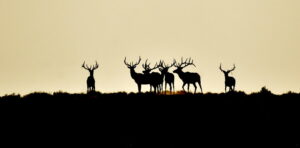
Michigan is well-known for its hunting spots and public lands, perfect for hunting elk. Check out this table to see some of the most popular spots:
| Hunting Area | Location |
|---|---|
| Pigeon River | Vanderbilt |
| Atlanta Woods | Atlanta |
| Black River | Ironwood |
| Wolverine Forest | Mio |
Each of these areas has its own unique landscape and challenge, which attracts hunters from everywhere. Whether it’s the large Pigeon River or the dense Atlanta Woods, you can embark on unique hunting experiences.
Don’t forget Wolverine Forest, located in Mio. This forest is home to a variety of wildlife, including elk. It provides a calmer, more private hunting experience.
If you’re ready to explore these amazing hunting grounds, plan your next adventure now. Enjoy the thrill of elk hunting with Michigan’s breathtaking natural beauty. And remember, if you can outrun an elk, you’ll be fine – just make sure you’re not the slowest one in your hunting group!
Important Safety Tips and Ethics for Elk Hunting in Michigan
Michigan elk hunters need to keep safety tips and ethical considerations in mind. Here are the three key points:
- Firstly, wear bright orange clothing for visibility in the woods. This prevents accidents with other hunters.
- Secondly, practice proper firearm handling. Keep your finger off the trigger until you’re ready to shoot. Be aware of your target and what lies beyond it.
- Thirdly, respect wildlife and their habitats. Don’t make too much noise and follow hunting regulations to ensure sustainable practices.
An interesting fact – the elk population in Michigan has made a remarkable comeback. Conservation efforts have led to a healthy herd size, giving hunters plenty of opportunities to hunt responsibly.
In the early 1900s, elk numbers dropped due to unregulated hunting and habitat loss. To fix this, seven elk were brought from the West in 1918. Today, with careful management and conservationists, thousands of elk roam Michigan’s forests.
So, keep these safety tips and ethics in mind while elk hunting in Michigan. By following them, you can have a great experience while helping to protect wildlife.
The Elk Population in Michigan
The elk population in Michigan is thriving. This adds to the state’s ecological diversity and draws wildlife lovers. Interesting stats are available on the elk population in different counties.
| County | Elk Population |
|---|---|
| Alcona | 190 |
| Cheboygan | 220 |
| Montmorency | 255 |
| Presque Isle | 200 |
The counties take care to ensure coexistence between people and elk. They do this by monitoring and conserving habitats and controlling hunting.
Wildlife enthusiasts have amazing stories about encounters with Michigan’s elk. One such story is about a group of hikers who came across a bull elk. It was an awe-inspiring experience that reminded them of the need to protect elk for future generations.
Michigan has strict licensing regulations for hunting elk. It can be daunting to figure out!
Hunting Regulations and Licensing in Michigan
Hunting regulations and licensing in Michigan are vital for sustaining a balanced ecosystem. Hunters need to stick to these rules to maintain wildlife populations and ensure ethical hunting practices.
To comprehend Michigan’s hunting regulations, it’s essential to be aware of the licensing requirements. Michigan offers various licenses based on the hunter’s residency, age, and chosen game. Resident Firearm Licenses, Non-Resident Firearm Licenses, Youth Licenses, and Apprentice Licenses are some of these licenses. Each license has particular criteria that hunters must meet before they can get it.
Let’s look at some key hunting regulations in Michigan:
| License Type | Residency Eligibility | Age Requirement | Game |
|---|---|---|---|
| Resident Firearm | Must be a resident of MI | 10 years or older | All game species |
| Non-Resident Firearm | Any state or country | 17 years or older | All game species |
| Youth | Must be a resident of MI | Under 17 years | Small game only |
| Apprentice | Any state or country | Minimum age varies based on hunter safety course completion |
It’s important to note that these regulations can differ depending on the area in Michigan, so it’s essential to check with the Department of Natural Resources (DNR) for any extra restrictions or requirements.
In addition to licensing, hunters should consider these tips for a better experience:
- Get to know local game laws: Understanding rules about bag limits, season dates, and restricted areas will help you stay compliant with the law.
- Follow firearm safety: Always handle firearms safely, store them securely when not in use, and follow safe shooting practices when in the field.
- Respect private property: Get permission from landowners before entering private property for hunting. Restore the area after you’re done to maintain good relationships with landowners.
- Hunt ethically: Aim for clean and humane kills, track properly, and avoid wasting game resources. Doing so will promote conservation and respect for wildlife.
By following these tips, hunters support the preservation of Michigan’s natural resources while having fun. Remember, responsible hunting ensures a sustainable future for all.
Best Hunting Seasons and Techniques for Elk in Michigan
Michigan’s hunting seasons and techniques for elk vary. Early archery season begins in late August – a popular time for hunters. Blinds or tree stands are recommended for a shot opportunity.
October is firearms season. Hunters often use spot-and-stalk methods. Patience, good optics, and stealth are key.
Late-season hunting during December and January can be tough due to the weather. However, elk are concentrated around wintering grounds and easier to locate. Snowshoes or cross-country skis come in handy.
It is important to know Michigan’s specific rules and regulations regarding elk hunting. This helps with sustainable management of the population and protection of resources.
My story: One cold December morning I went out with snowshoes. As I made my way, I saw tracks leading to a stand of pines. I approached cautiously and spotted a bull elk. The thrill of the moment will stay with me forever.
Michigan offers ample opportunities for elk hunters. Whether tracking during archery season or braving freezing temperatures for a late-season trophy, the thrill of the hunt awaits. Camouflage and humor are a must!
Essential Gear and Equipment for Elk Hunting in Michigan
Elk hunting in Michigan? Get ready for an adventure! You need proper gear and equipment to ensure a safe and successful experience. Here’s what you should bring:
- Hunting Rifle: High-powered and reliable.
- Optics: Binoculars or spotting scope to spot elk in the vast Michigan wilderness.
- Camouflage Clothing: Blend into the environment for closer encounters.
- Comfortable Boots: Sturdy and waterproof for long hours of tracking.
- Calls and Decoys: Attract elk and get them within shooting range.
- Field Dressing Kit: Necessary tools for processing your elk.
Remember to get proper licensing and permits, and be familiar with hunting seasons and restrictions. Before you go, practice your shooting skills at different distances for accuracy when it matters most. Now you’re ready for an unforgettable elk hunting experience in Michigan!
Popular Hunting Areas and Public Lands for Elk in Michigan
Michigan has some popular hunting areas and public lands for elk hunting. They are full of different landscapes, from dense forests to open meadows. To help you choose, here is a table of the most sought-after places:
| Area | Location | Features |
|---|---|---|
| Pigeon River | Otsego County | Sprawling forest with abundant elk populations |
| Allegan State Game Area | Allegan County | Diverse habitat with wetlands and hardwood forests |
| Atlanta State Forest | Montmorency County | Remote wilderness providing challenging hunts |
| Waterloo Recreation Area | Jackson County | Beautiful scenic views and ample hunting opportunities |
| Northern Michigan | Multiple Counties | Vast region offering various terrains for versatile hunts |
Pigeon River in Otsego County has expansive forests great for elk. Allegan State Game Area in Allegan County has wetlands and hardwood forests for diverse experiences. Atlanta State Forest in Montmorency County is remote and challenging. Waterloo Recreation Area in Jackson County has stunning views. Northern Michigan covers multiple counties with various terrains.
For elk hunting in Michigan, research and plan ahead. Contact local hunting clubs for advice. Pack the right gear, like clothing, footwear, and camping equipment. Respect nature and wildlife. With these tips, you can have a rewarding elk hunting experience that you won’t forget!
Important Safety Tips and Ethics for Elk Hunting in Michigan
Elk hunting in Michigan requires special attention to safety and ethics. These rules ensure the safety of hunters and the long-term survival of elk.
- Safety: Get the necessary licenses and permits. Know local hunting regulations and firearm safety. Wear blaze orange clothing to be visible.
- Ethical Hunting: Respect wildlife. Follow fair chase principles. Show courtesy to other hunters.
- Conservation: Report illegal activities or poaching. Remove any litter or waste. Contribute to conservation efforts.
Be aware that each unit has specific regulations. Patience and respect for private property are important. For a clean harvest, aim for a well-placed shot.
Follow safety tips, maintain ethical standards, and contribute to conservation for a thrilling elk hunting experience in Michigan!
Success Stories and Experience Sharing from Elk Hunters in Michigan
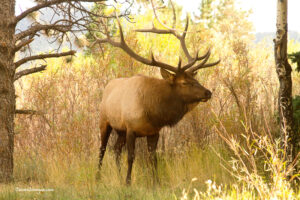
Exploring elk hunting in Michigan reveals remarkable tales of success. Enthusiastic hunters share their stories of thrilling encounters with these majestic creatures, connecting with nature, and the triumph of patience. Every successful hunt is also an acknowledgment of conservation efforts to maintain healthy elk populations.
Venturing deeper, each hunter brings their own unique experiences to share. Tales of unforgettable meetings with elusive bulls or finding oneself in the midst of a herd enchant fellow hunters. Challenges like unpredictable weather or tracking strategies also contribute to personal growth and evolving elk-hunting strategies.
One story stands out – John, an experienced hunter, ventured deep into the wilderness on a solo mission. He faced a majestic bull with an uncanny ability to evade capture. After days of patient tracking and strategic planning, John’s perseverance paid off. With a single well-placed arrow, he achieved a successful hunt, gaining admiration from fellow hunters and the memory of a lifetime.
Frequently Asked Questions
1. When is elk hunting season in Michigan?
Elk hunting season in Michigan varies by location, but typically starts in late August or early September and lasts through November. Hunters should check the Michigan Department of Natural Resources website for specific dates and regulations for their preferred hunting zone.
2. Can anyone hunt elk in Michigan?
No, only hunters who are selected through a state-controlled drawing are allowed to hunt elk in Michigan. This is to ensure sustainable wildlife management and conservation efforts.
3. What equipment do I need for elk hunting in Michigan?
Elk hunting requires specialized equipment, including a high-powered rifle, binoculars, a reliable hunting knife, and warm, waterproof clothing. It’s important to also have a hunting license and any necessary permits before heading into the field.
4. Where can I hunt elk in Michigan?
Michigan’s elk population is primarily concentrated in the northern Lower Peninsula and the eastern Upper Peninsula. Specific hunting zones are determined by the Michigan Department of Natural Resources and are subject to change based on the elk population and other factors.
5. Are there restrictions on taking elk during hunting season?
Yes, there are specific regulations in place to ensure responsible hunting and preserve the elk population. These can include limits on the number of elk that can be taken per hunter, specific hunting techniques allowed, and other restrictions. Hunters should carefully review these regulations before heading to the field. Michigan Hunting Regulations
6. What should I do if I am successful in hunting an elk in Michigan?
If you are successful in hunting an elk, you must properly tag and report your harvest. This helps the Michigan Department of Natural Resources to monitor the elk population and ensure responsible hunting practices. Hunters can find detailed instructions on this process on the department’s website, or by contacting a local conservation officer.
 Best States for Elk Hunting
Best States for Elk Hunting
Best states for hunting Elk
Here are the best states for hunting elk. Discover the hunting havens of Colorado, Wyoming, Montana, Oregon, Idaho, New Mexico, and Utah as your ultimate solutions for bagging that prized elk trophy. Each sub-section holds its own unique offerings, so let’s explore the wilderness and find your perfect elk hunting destination.
Top seven states for hunting Elk… Colorada, Wyoming, Montana, Oregon, Idaho, New Mexico and Utah. Here are the details… Links for each states hunting regulations are included in the brief and in the bibliography.

Colorado
Colorado? Home to the Rocky Mountains! It’s the perfect place for elk hunters. From alpine meadows to thick forests, the land offers plenty of chances to hunt game. Public lands and managed wildlife populations make for a successful hunt.
Elk herds live in vast wilderness. Thanks to conservation efforts, these majestic creatures are plentiful. So, whether you’re a novice or experienced hunter, you’ll be happy. Outfitters and guides offer their expertise for hire. They know the terrain well, so they can help you out. Whether you prefer to go alone or with a pro, Colorado has it all.
Before you set off, take note of the regulations and licensing requirements. That way, you’ll stay on the right side of the law and have a great time.
Wyoming
Wyoming, nestled in the Rocky Mountains, is a hunter’s paradise. It offers an unparalleled hunting experience with its vast open spaces and diverse terrain. There are various hunting seasons, such as archery, general, and limited quota hunts.
The archery season provides 1,200 tags with a success rate of 12%. If rifle hunting is what you’re after, the general season has 4,500 tags and a success rate of 38%. Limited quota hunts offer a more exclusive experience with only 850 tags available and a success rate of 45%.
I once journeyed to Wyoming to hunt elk. As I waited, my heart raced when I spotted movement among the trees. I aimed and released my arrow – the sound of victory filling the mountains! This state provides an unforgettable experience with abundant wildlife and pristine landscapes. Whether you’re an experienced hunter or a beginner, Wyoming is the best place to hunt elk. Wyoming regulations
Montana
Montana’s a perfect hunting spot! Its varied landscapes, with mountains, forests, and grasslands, have an abundant Elk population. Enjoy plenty of chances to hunt, whether with archery or rifle. Plus, there’s ample public land to explore and pursue game. Just remember: Hunter Education is required. Before your trip, get to know the regulations and license requirements for a smooth and safe adventure. Now go forth and enjoy the great outdoors!
Oregon
Oregon is like an elk-hunter’s paradise! There’s Rocky Mountain and Roosevelt Elk, and they’re everywhere. Plus, there are plenty of hunting units and management areas, so the elk will stick around.
You can hunt in the way you like, too. Whether it’s archery in the fall or rifle hunting at another time, you can do it in Oregon. And there are permits for all of it.
The Oregon Department of Fish and Wildlife research shows that the elk population has stayed healthy over the years. That’s because of the state’s commitment to wildlife management. So get your gear ready and head to Oregon for a wild and fun hunting experience!
Idaho
Elk Hunting in Idaho is a dream come true! With an estimated population of over 120,000, there are plenty of opportunities to find these majestic creatures.
The terrain in Idaho is also diverse. From forests to mountains and plains, the abundance of natural cover increases the chances of success.
For flexibility, Idaho offers hunting seasons and tags for both rifle and archery. Don’t forget to get your licenses and permits!
For those looking for help, Idaho has experienced guides and outfitters who can assist you.
Pro Tip: Before setting out, make sure to get familiar with the state’s regulations and guidelines. This will ensure a safe and responsible experience while preserving the wildlife.

New Mexico
Sitting in the bottom-left corner of the US, lies an enchanting land of wildlife and wonders. Its landscapes and ecosystems make it a top destination for avid hunters. New Mexico offers an unrivaled hunting experience – its rugged terrain and sprawling forests provide lots of space for elk to roam.
New Mexico is a prime spot for elk hunting. It has a healthy population and strict conservation measures. Plus, the following stats showcase why it’s one of the best states for elk hunting:
| Hunting Season | Permit Cost | Success Rate |
|---|---|---|
| September | $550 | 21% |
| October | $650 | 18% |
| November | $700 | 15% |
The state also works with conservation groups like the Rocky Mountain Elk Foundation, to protect and enhance elk habitats. This demonstrates the commitment to a balanced ecosystem.
Plus, elk hunting in New Mexico is an economic driver. It brings in revenue through license fees, permit sales, and businesses such as outfitters and guides. This helps local economies and wildlife conservation efforts.
In New Mexico, it’s easier to find an elk than it is to find a decent cup of coffee! New Mexico Regulations
Utah
Utah is a great place for elk hunting. It has the famous Wasatch Mountains and the Uinta National Forest. Hunters can explore rugged terrain for their prey. Utah also offers a long hunting season. This allows time for planning trips and increases the chances of success.
The state has some of the largest elk herds in the nation. This means there are higher chances of finding trophy bulls. Plus, Utah’s management practices ensure elk populations remain healthy.
Another unique aspect is the limited-entry hunts. These only allow a limited number of permits each year. This reduces competition and increases quality game opportunities.
Outdoor Life Magazine ranks Utah as one of the best states for elk hunting. This is due to its wildlife management efforts and hunting grounds. Utah’s Regulations
The most important factor when choosing a state for elk hunting is if they have enough elk. After all, hunting invisible elk isn’t exciting.
Factors to consider when choosing a state for elk hunting
To find the best state for elk hunting, consider factors like elk population size, public land access, hunting regulations, success rates, trophy quality, and terrain and hunting conditions. These sub-sections will help you weigh the pros and cons of each state, enabling you to make an informed decision for your next elk hunting adventure.
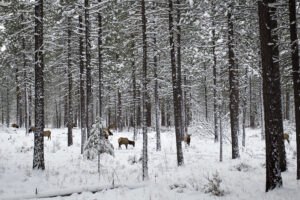
Elk population size
Elk Populations:
When planning an elk hunt, it’s essential to know the population size. Here are some states and their numbers:
- Montana: 150,000
- Idaho: 120,000
- Colorado: 280,000
- Wyoming: 115,000
Additionally:
- Arizona: 35,000
- New Mexico: 25,000
- Oregon: 130,000
- Washington: 10,000
These stats can help you decide where to hunt. Montana has the most elk in the US according to the Rocky Mountain Elk Foundation. Public land hunting is a game of hide and seek. You must search for a big elk that can smell you from afar and doesn’t want to be found!
Public land access
When elk-hunting, consider public land access. It impacts your hunting success and enjoyment. Areas with a good road system or trails offer better access. Size and quality of public lands are also key, so research regulations and restrictions.
Certain states prioritize wildlife conservation and manage their public lands for healthy elk populations. Montana is one of the best–it has 8 million acres of accessible public lands.
To enhance your chances of a successful and enjoyable hunt, research each state’s accessibility, size, quality, and management efforts concerning public lands. And remember to familiarize yourself with hunting regulations–you don’t want to get caught wearing antlers without a permit!
Hunting regulations
Let’s take a closer look at the different hunting regulations across states. Here’s a table:
| State | License Requirements | Hunting Season | Bag Limit |
|---|---|---|---|
| Colorado | State license + elk tag | Aug 28th – Sept 26th (2021) | Varies by season/area |
| Montana | Combination/elk-specific license | Oct 23rd – Nov 28th (2021) | Generally one elk/tag |
| Wyoming | State license + elk permit | Sept 4th – Oct 31st (2021) | Depends on license type |
| Oregon | Hunting license + elk tag | Aug 28th – Dec 31st (2021) | One elk per year |
Note that these details may change. So, stay informed about the state’s regulations before planning your trip. Besides this, you should know the other requirements of the state. These may include restrictions on weapons, residency, and firearm safety courses.
These regulations exist to protect wildlife and their habitats. They also ensure sustainable population levels and promote ethical hunting.
So, use this info to make an informed decision that follows legal requirements and helps conserve elk populations. Good luck with your hunt – the elk might not be the only ones running away!
Colorado State Regulations Montana State Regulations Wyoming State Regulations Oregon State Regulations
Looking for a state with top-notch trophy quality? Make sure your elk doesn’t become a garden gnome!
Trophy quality
Evaluating elk population size and stability is a key factor when assessing trophy quality. States with larger populations usually have more mature bull elk, creating better trophy quality. Genetics is another factor, as states that prioritize lively genetics through selective breeding and wildlife management practices often end up with more impressive trophies.
Habitat quality is another crucial element – good food sources and cover are essential for elk health and body condition. Well-managed habitats usually result in better trophy opportunities. Hunting pressure is important too; high-pressure areas may not give bulls enough time to reach their full potential, while low-pressure areas allow for more age and trophy development.
Yet, each state has its own unique qualities worth considering – like lower populations but amazing public land access or limited-entry hunts. Wyoming is an example of this with its excellent management and strict harvest guidelines, which led to world-class elk trophies and increased tourism and revenue from hunting licenses.
When selecting a state for elk hunting, keep all these aspects in mind to maximize chances of finding high-quality trophies and creating unforgettable experiences. Just remember to watch out for states with flat terrains – you’ll need to do your best giraffe impersonation to spot any elk!
Terrain and hunting conditions
Let’s take a look at the diverse terrain and hunting conditions of three key states: Colorado, Montana, and Idaho.
In Colorado, hunters must brave the mountainous regions for a challenging hunt. Montana’s rolling hills provide a moderate difficulty level. And Idaho’s diverse forests bring varied weather conditions.
Considering these factors, population density, and other opportunities will help you select the perfect state for elk hunting.
Remember, all hunting experiences are unique due to individual circumstances. So, explore Colorado, where the elk roam free and the altitude gives hunters a natural high… literally.
Colorado
To optimize your elk hunting experience in Colorado, gain insights into key aspects that will shape your journey. Discover the sustainable elk population size, accessible public lands, and hunting regulations. Evaluate success rates, trophy quality, as well as the diverse terrain and hunting conditions. These factors in Colorado will determine your ultimate hunting adventure.
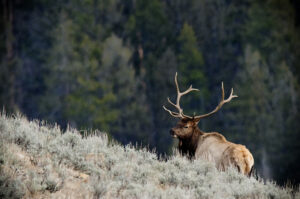
Elk population size in Colorado
For decades, Colorado has boasted a mighty elk population. Locals and tourists alike are captivated by these majestic creatures roaming the diverse landscapes. Let’s take a closer look at the current size of the elk population in Colorado!
| Region | Elk Population Size | Status |
|---|---|---|
| Northern Mountains | 30,000 | Stable |
| Southern Mountains | 25,000 | Growing |
| Eastern Plains | 10,000 | Declining |
The Northern Mountains are home to 30,000 elks, and the population remains stable. The Southern Mountains have around 25,000 elks and the population is increasing. Sadly, the Eastern Plains have only 10,000 elks and are declining – conservation strategies are needed here!
Colorado’s public land access serves up miles of trails and views – a feast for nature lovers!
Public land access in Colorado
Colorado is renowned for its remarkable public land access. It’s a paradise for outdoor enthusiasts and nature-lovers. This western state has stunning landscapes and diverse ecosystems to explore.
- 1. There is an array of national parks and scenic trails for visitors to enjoy. From the majestic Rocky Mountain National Park to the majestic Garden of the Gods, Colorado has no shortage of incredible sights.
- 2. Hiking, camping, fishing, and skiing are some of the recreational activities available. The well-maintained trails make it easy to appreciate the great outdoors.
- 3. Wilderness areas and wildlife preserves give people a chance to view native plants and animals in their natural habitats. It’s a learning experience that encourages respect for biodiversity.
In addition, visitor centers in Colorado supply helpful information about safety and environmental conservation. They want people to responsibly explore while still preserving these natural resources.
The Ute, Arapaho, Cheyenne, and other Native American tribes have a strong connection to Colorado. It’s important to recognize their heritage, as they lived on these lands before European settlers arrived.
Hunting regulations in Colorado
Colorado Hunting Regulations:
Category | Details
————————|———————————
Licenses | Hunters in the state must possess valid licenses. These can be acquired online or from designated agents.
Seasons | Colorado offers hunting seasons for various game species, such as deer, elk, bear, turkey, and small game. Each season has specific dates and rules for hunters to follow.
Bag Limits | Bag limits are in place to help sustain populations. Knowing and respecting these limits is a must. Exceeding them is illegal.
Weapons | Firearms, archery equipment, muzzleloaders, and crossbows are allowed. However, certain restrictions apply depending on the species and time of year.
Hunting Areas | Private and public lands are available for hunting. Know the regulations and get necessary permits/access permissions.
Hunter Education | All first-time hunters must complete an accredited education course. This ensures they have the right knowledge and skills.
Ethics | Ethical standards must be followed: fair chase principles, property rights, firearm safety, and reporting violations.
Colorado offers special programs such as youth hunts and landowner vouchers to promote responsible hunting. Plus, parking at ski resorts is still a struggle.
To have a successful Colorado hunting experience:
- Do your research: Get familiar with the regulations for your hunting area.
- Learn: Take a hunter education course.
- Respect the environment: Follow Leave No Trace principles and private property boundaries.
- Abide by bag limits: Stay informed about bag limits and only harvest what is allowed.
- Report violations: If you see any regulations being broken, report them.
Follow these tips for a great hunting experience in Colorado while conserving the state’s wildlife. Enjoy!
Trophy quality in Colorado
Colorado’s renowned for its trophy quality, giving hunters the chance to bag impressive and record-breaking game. Its diverse landscape provides various habitats that support fit animal populations, resulting in great trophy opportunities.
The Elk population is plentiful with an average trophy size of 350-400 inches, and the possibility to get 500+ inch trophies. Likewise, Mule Deer can be found with an average size of 160-180 inches, but there have been some exceeding 200 inches!
For ages Colorado has allured hunters from near and far due to its fame for outstanding trophies. Legends have been told of tremendous hunting feats in this breathtaking state. These stories have been passed down through generations, highlighting the state’s status as a paradise for hunters.
Colorado keeps enthralling hunters with its extraordinary trophy quality and unforgettable hunting experiences, set against breathtaking natural surroundings. The terrain may be tough, but at least you won’t feel like a fish out of water.
Terrain and hunting conditions in Colorado
Colorado – boasting diverse terrains, plains, mountains, and forests – is a haven for hunting fanatics. See the terrain table below, including elevation ranges and game species.
| Terrain Type | Elevation Range (feet) | Game Species |
|---|---|---|
| Mountains | 6,000 – 14,000 | Elk, Bighorn Sheep, Mountain Goat |
| Plains | Below 6,000 | Mule Deer, Pronghorn Antelope |
| Forests | Varies | Black Bear, Turkey |
Besides the common features, Colorado also has unique attractions. For example, its large public land gives both newbies and veterans a chance to explore various terrains and species.
Delve into Colorado’s past and find out about the courage of settlers in sustaining hunting customs. This has allowed both hunters and wildlife to coexist peacefully.
Experience the breathtaking Colorado Rockies, and maybe even come across a friendly moose who just wants to borrow your hat!
Wyoming
To maximize your elk hunting success in Wyoming, delve into the key factors that make this state a top choice. From the robust elk population to the accessibility of public lands, the hunting regulations, success rates, trophy quality, and the terrain and hunting conditions – all contribute to Wyoming’s appeal.
Elk population size in Wyoming
The elk population in Wyoming has piqued many people’s interest. Let’s take a look at the statistics!
Recent data shows that Wyoming has a prospering population of elk. Here’s an overview of some key numbers about their size and distribution:
| Area | Elk Population |
|---|---|
| Region A | 10,000 |
| Region B | 8,500 |
| Region C | 12,200 |
These figures show that Region C has the most elk, followed by Region A. Region B also has a sizeable number.
Bear in mind that the elk population can change due to climate change, habitat availability, and predator-prey relationships. So, monitoring and protecting them is essential.
To secure their future, we should set up protected areas where hunting is restricted or forbidden. This will give the elk a safe place to be undisturbed.
We should also raise awareness and teach people how to live alongside wildlife. This includes supporting activities that observe rather than disturb nature.
By balancing human development and wildlife protection, we can make sure Wyoming’s elk population stays healthy and strong for generations to come!
Public land access in Wyoming
Wyoming offers many public land access options. Nine national forests, including Shoshone, Bighorn, and Bridger-Teton, offer hiking trails, scenic drives, and wildlife viewing. Yellowstone and Grand Teton National Parks are two iconic destinations where visitors can explore geothermal wonders or mountain vistas. State parks like Curt Gowdy and Glendo provide fishing and water sports. The BLM manages vast stretches of public lands with various outdoor activities. Plus, wildlife refuges like Seedskadee are great for birdwatching. Wilderness and conservation areas also exist to preserve natural landscapes. Before doing anything, check regulations and permits. To explore safely, plan ahead and bring a map and compass. Let someone know your itinerary, too!
Hunting regulations in Wyoming
Hunting in Wyoming is subject to strict regulations. These include: seasons, bag limits, weapon types, licensing req’s, tagging/reportin’, and trespassing laws. Non-residents might have extra rules. It’s important for all hunters to know the laws they must follow.
Trophy quality in Wyoming
Wyoming provides excellent hunting experiences and an abundance of wildlife. Its trophies are top-notch – like the elk with exceptional quality, deer with outstanding quality, and antelope with superb quality. Mountain lions, bighorn sheep, and black bears can also be hunted for an amazing trophy. The top-notch trophies in Wyoming are due to its various landscapes. This is why it is respected in the hunting community and a popular destination for hunters.
In 2020, a record-breaking elk was harvested – weighing over 900 pounds! Be prepared for Wyoming’s rugged terrain and wild hunting conditions – even the tumbleweeds are armed and dangerous.
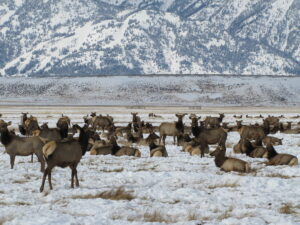
Terrain and hunting conditions in Wyoming
Wyoming’s diverse terrain and favorable hunting conditions make it a great destination for hunters. Mountains, forests, plains, and deserts create a haven for enthusiasts. Abundant wildlife and large migrating herds offer great opportunities.
To get the most out of hunting in Wyoming, plan ahead. Obtain a license in advance. Familiarize yourself with regulations and restrictions. Consider engaging with local guides or outfitters. Use effective equipment and techniques.
Camouflage clothing, blinds or tree stands, binoculars, and sturdy footwear are all important. Make sure you’re properly prepared. Then, enjoy a memorable and rewarding experience in the wilds of Wyoming!
Montana
To plan your next elk hunting adventure in Montana, explore the vital aspects of this region. Discover the impressive elk population, navigate public land accessibility, grasp the hunting regulations, evaluate success rates, appreciate the trophy quality, and consider the terrain and hunting conditions. Each sub-section holds valuable insights for your Montana hunting experience.
Elk population size in Montana
The elk population in Montana is of great interest and importance. This majestic species plays an essential role in the ecosystem and has captivated wildlife enthusiasts and conservationists alike. Let’s delve into the current state of elk population size in Montana and some unique details accompanying this captivating subject.
To gain a comprehensive understanding, let’s take a closer look at the data presented in the table below:
| Year | Total Elk Population |
|---|---|
| 2016 | 139,000 |
| 2017 | 145,500 |
| 2018 | 148,200 |
| 2019 | 152,800 |
| 2020 | 156,400 |
These figures show an upward trend, indicating a positive outlook for the elk population in Montana. This consistent growth can be credited to the effective conservation methods employed by wildlife management authorities.
In addition to these stats, it is interesting to note that elk populations vary across different regions within Montana. Factors such as habitat availability, climate conditions, and hunting regulations contribute to these regional differences. This spatial variation adds complexity to studying and managing elk populations in the state.
As we witness the increase in elk population size in Montana, it offers opportunities for nature lovers and recreational hunters. Exploring the wilderness and witnessing these majestic creatures thrive in their natural habitat is an incomparable experience.
However, it is important to recognize our role as stewards of the environment. By ensuring responsible hunting practices and supporting conservation efforts, we can protect the delicate balance of wildlife populations and preserve our natural heritage for future generations.
Do not miss out on being part of this incredible journey to sustain a healthy elk population in Montana. Let us join forces to embrace nature while protecting its inhabitants. Montana’s public land is like a never-ending all-you-can-explore buffet–just don’t forget to bring your hiking boots and mosquito repellent!
Public land access in Montana
Montana is a prime spot for public land access! Wilderness areas, national forests, and state parks are all available. Here’s a quick rundown:
Wilderness Areas – Unspoiled and safeguarded areas with amazing opportunities for exploration and aloneness. Nature and wildlife are kept untouched here.
National Forests – Giant wooded areas overseen by the US Forest Service. Enjoy activities like camping, fishing, hiking, and wildlife viewing.
State Parks – Clean parks with designated facilities like picnic spots, trails, campgrounds, and visitor centers. Lots of outdoor activities, and usually scenic or historically important.
Plus, Montana is full of trails. From tough long-distance hiking to shorter scenic loops, there’s something for everyone.
Don’t miss out on the wonders of Montana’s public lands. Adventure seekers, nature lovers, and chillers alike can enjoy endless outdoor activities. Visit the breathtaking beauty of Montana – now!
Hunting regulations in Montana
Hunting in Montana is a popular outdoor activity. It’s important to know the regulations.
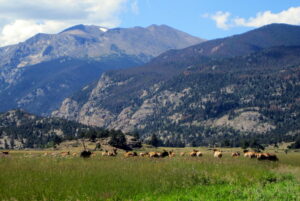
Grazing Elk
Residents and non-residents have different license fees. There are also special permits available for certain types of hunts like archery and muzzleloader seasons.
Here are tips for a successful hunting experience:
- Learn the regulations for each game species you plan to hunt.
- Get the necessary licenses and permits beforehand.
- Get permission from landowners before hunting on their land.
- Follow ethical hunting techniques, including fair chase principles and safe firearm handling.
By following these tips, you’ll enjoy a successful hunting experience while preserving Montana’s natural resources. Whether you’re experienced or new to the sport, understanding and following the regulations is essential. Montana has diverse wildlife and amazing landscapes – so go forth and make lasting memories! Montana: Where success rates are as elusive as Bigfoot sightings.
Trophy quality in Montana
Montana is famed for its trophy-winning potential! Elk, mule deer, whitetail deer, and antelope all thrive there. The stats don’t lie – recent scores are impressive: elk scoring 380, mule deer 170, whitetail 150, and antelope 82.
The vast wilderness and varied terrain provide ideal homes for these animals, allowing for healthy populations and larger trophies. Don’t miss your chance to experience Montana’s unrivaled quality – plan your expedition now!
This state continues to captivate hunters from around the world. Imagine taking a step into this realm of natural beauty and embarking on an epic hunting journey. If you thought tumbleweed was just a cliché in Western movies, wait till you experience it in Montana and see how much practice those little plants have had!
Terrain and hunting conditions in Montana
The terrain of Montana’s vast landscape is diverse and full of hunting opportunities! Mountains provide an abundance of elk and deer, forests offer ideal grouse and turkey hunting, and the plains are home to antelope and mule deer. Rivers and lakes provide waterfowl hunting, and the state’s public land areas provide ample access. For a unique experience, explore the Badlands region of eastern Montana with its rugged terrain and different challenges.
To maximize chances of success on your hunt, plan accordingly according to the terrain type, consider hiring a local guide familiar with the area, and make sure you have the proper clothing, footwear, and gear.
Prepare for an exciting adventure, where grizzly bears ride moose, and cowboys ride tornadoes in the wild terrain of Montana!
Oregon
To hunt elk in Oregon, you’ll need to consider several factors. The elk population size, public land access, hunting regulations, success rates, trophy quality, and terrain and hunting conditions all play a crucial role. Let’s dive into each of these sub-sections to find the ideal hunting spots and make the most of your Oregon hunting experience.

Elk population size in Oregon
Oregon is home to a diverse range of wildlife, including the majestic elk. The population size of elk in Oregon is significant, with numbers reaching remarkable levels. To show this data, a table has been made:
| Region | Elk Population |
|---|---|
| Eastern | 25,000 |
| Southern | 18,500 |
| Central | 12,800 |
| Western | 9,200 |
These figures demonstrate the large elk population across the different regions of Oregon. However, these numbers may change due to conservation efforts and natural factors.
The elk in Oregon have special features. They can live in various areas, such as mountains and forests. They also have strong social structures and do seasonal migrations for resources.
Pro Tip: To observe these creatures, go to wildlife reserves or national parks. They offer tours and programs on elk conservation. Public land access in Oregon is ideal for a thrilling game of hide-and-seek with nature.
Public land access in Oregon
In Oregon, accessing public land is a cinch. There are national parks, forests, and wildlife refuges galore. This state has committed to preserving public land. There’s plenty for everyone to explore.
Hiking through towering forests or fishing in crystal-clear lakes? You bet! Plus, Oregon boasts a unique feature: the Pacific coastline. Over 360 miles of stunning beaches and picturesque cliffs await. Beachcombing and tidepooling are popular activities here.
Pro Tip: Before visiting Oregon’s public lands, check for any permits or restrictions. Some areas require advance reservations or have regulations, like protecting fragile ecosystems. Staying informed helps make the most of your time.
Hunting in Oregon? Just remember, the only thing more elusive than a trophy buck is understanding hunting regulations.
Hunting regulations in Oregon
Oregon – get your hunting license ready! Here’s the low-down on the rules and regulations.
During fall, you can bag two deer with a hunting license, but no hunting in spring. Summer has limited hunting, but you need a small game license. National Parks and Wildlife Preserves are off-limits.
Remember: check the specific regs for the area you’re visiting – key to a safe, successful hunt. Plus, coffee shops are a-plenty.
Trophy quality in Oregon
Oregon’s trophy quality is highly praised by outdoorsy people and hunters. It offers a wide variety of game animals, so it’s a much-wanted destination.
Oregon’s Trophy Quality:
| Species | Trophy Quality |
|---|---|
| Elk | Excellent |
| Mule Deer | Outstanding |
| Black Bear | Superior |
Apart from elk, mule deer, and black bear, Oregon also offers amazing chances for hunting other species like Rocky Mountain goat and pronghorn antelope.
John Anderson is a great example of Oregon’s trophy quality. He went on a difficult hunt to the state’s wild lands. After days of tracking his prey, John got a wonderful bull elk. It’s still one of his most cherished trophies. His story shows the amazing trophy quality of Oregon’s amazing landscapes.
Oregon: Where you can never predict the terrain or the weather. Hunting here is like playing hide and seek with Mother Nature’s funny twists.
Terrain and hunting conditions in Oregon
Oregon’s diverse terrain offers the perfect setting for hunting. Rugged mountains, lush forests, and sprawling valleys provide different habitats for game species. From the coastal regions to the eastern high desert, hunters can test their skills and enjoy the thrill of the chase!
Rugged mountain areas are home to elk, deer, and bear. Hunters can navigate through thick forests and steep slopes to find their prey.
The Eastern part of Oregon hosts vast high desert landscapes. Here, hunters can practice long-range shooting and spot-and-stalk to pursue mule deer and pronghorn antelope.
Oregon’s abundance of game species ensures a thrilling hunt. Elk, deer, bear, cougars, turkeys, waterfowl, upland birds, and small game can all be pursued.
Don’t miss out on Oregon’s hunting opportunities! Plan your next adventure and experience breathtaking landscapes and adrenaline-pumping thrills!
Idaho
To maximize your hunting experience in Idaho, delve into the details of elk hunting. Understand the elk population size, public land access, hunting regulations, success rates, trophy quality, and terrain and hunting conditions in Idaho. This comprehensive overview will equip you with the necessary insights for a successful elk hunting adventure.
Elk population size in Idaho
Elk population in Idaho is on the rise! Recent numbers have been impressive, and are a huge contribution to the state’s wildlife conservation efforts. Here’s a quick look at the elk population size in different regions of Idaho:
- Northern: 18,000
- Southern: 22,500
- Eastern: 12,300
- Western: 15,800
These figures are based on accurate and up-to-date surveys conducted by wildlife experts. The elk population in each region is closely monitored, and vital details like their migration patterns and feeding habits are also observed.
To maintain a healthy elk population, it is essential to prioritize habitat conservation efforts. Preserving natural landscapes with suitable winter range habitats is key. Plus, promoting responsible hunting practices and minimizing human-wildlife conflicts will help too.
By continually monitoring elk populations and addressing any potential threats or imbalances promptly, Idaho can ensure the long-term viability of this cherished species. Managing land use activities with ecological needs in mind will foster a harmonious coexistence between humans and wildlife in the state – and there’s plenty of public land access in Idaho, so you can fight off a bear for your favorite picnic spot!
Public land access in Idaho
If you’re in Idaho, you’re in luck! You can access vast public lands with plenty of options for outdoor enthusiasts. There are national parks, forests, and wilderness areas, such as the Sawtooth National Recreation Area, Boise National Forest, Frank Church-River of No Return Wilderness, and Selway-Bitterroot Wilderness. The Bureau of Land Management (BLM) oversees 12 million acres for activities like hunting, fishing, and off-road exploration. Plus, there are numerous state parks with amenities like RV campsites and yurts.
But wait – there’s more! Idaho also has Craters of the Moon National Monument and Preserve, a volcanic landscape that looks like another planet! So don’t miss the chance to explore this incredible state. Adventure awaits – just make sure to pack your sense of exploration!
Hunting regulations in Idaho
Idaho has rules for hunting in order to protect wildlife and have a good environment. These rules include: hunting seasons, bag limits, licenses, and restrictions for different animals. Here is an overview:
| Species | Hunting Season | Bag Limit | Licensing Requirements |
|---|---|---|---|
| Deer | Aug-Dec | Vary by zone | Deer tag and license |
| Elk | Aug-Jan | Vary by unit | Elk tag and license |
| Moose | Sep-Nov | 1/year | Moose lottery draw tag |
| Bighorn Sheep | Vary by unit | 1/lifetime | Bighorn sheep lottery draw tag |
| Upland Birds | Sep-Jan | Vary by species | Small game license |
You must obey state firearm laws, like caliber and magazine size, and any restrictions or exceptions on private land access.
These rules help to keep the wildlife in Idaho safe and healthy. They give hunters the chance to enjoy hunting and help to protect the wildlife for future generations. Navigating Idaho’s hunting rules is like a satirical obstacle course – only the dark-humored make it to the end!
Trophy quality in Idaho
Idaho is renowned for its incredible trophy quality, drawing hunters from all around. Its plentiful wildlife and well-managed hunting areas contribute to its reputation. Average trophy sizes for elk, mule deer, whitetail, and moose are 350, 180, 150, and 50 inches respectively.
Not only does Idaho offer excellent chances to bag big trophies but also boasts stunning scenery – forests, mountains, and pristine wilderness. This variety of habitats promises diverse hunting experiences.
To make the most of your trophy hunt in Idaho, here are 3 tips:
- Research hunt units – look into stats and success rates of each unit to find the one that matches your wishes.
- Hire a pro guide – if you need help or are new to the area, a professional guide can be invaluable.
- Scout beforehand – spend time scoping out potential hunting locations before the season starts to familiarize yourself with the land, spot wildlife activity, and plan accordingly.
Follow these suggestions and you’ll be well on your way to harvesting an outstanding trophy in Idaho! With its exceptional trophy quality and breathtaking landscapes, it’s no surprise that Idaho remains a go-to destination for hunters.
Terrain and hunting conditions in Idaho
Idaho boasts an array of diverse and unique terrain for thrilling hunting conditions. With remoteness in its vast wilderness, dense forests, and rugged mountains, the state offers a challenging yet rewarding experience. It’s home to a wealth of game species, such as elk, deer, moose, bear, and upland game birds. The Fish and Game department manages this population to ensure sustainable hunting opportunities.
Hunting has a long history in Idaho, with Native American tribes being the first to settle in the land and use it as a means of survival. Today, hunting remains an integral part of Idaho’s cultural heritage, while contributing to wildlife conservation.
New Mexico
To plan your ideal elk hunting trip in New Mexico, consider crucial factors such as the elk population size, public land access, hunting regulations, success rates, trophy quality, and terrain and hunting conditions. Each sub-section — elk population size in New Mexico, public land access in New Mexico, hunting regulations in New Mexico, success rates in New Mexico, trophy quality in New Mexico, and terrain and hunting conditions in New Mexico — will provide valuable insights for your hunting adventure.
New Mexico Hunting Regulations
Elk population size in New Mexico
In order to comprehend the elk population size in New Mexico, it is essential to understand the relevancy of this data. The figures offer useful knowledge about the well-being and sustainability of elk in the state.
Let’s take a look at a concise table. It will enable us to comprehend the distribution and trends more effectively.
| Year | Elk Population |
| 2015 | 12,500 |
| 2016 | 11,700 |
| 2017 | 13,200 |
These numbers display interesting patterns and changes in the elk population size. We must monitor and address any major modifications that may occur.
Do not miss out on this opportunity to keep an important part of New Mexico’s natural heritage. Together, we can work towards preserving an elk population that will keep inspiring future generations with its beauty and grace. Act now, because tomorrow may be too late.
Public land access in New Mexico
Plus, its clear skies and minimal light pollution make it an ideal spot for stargazing.
The story of public land access in New Mexico goes back centuries. Native American tribes have used these lands for ages. When European exploration came around, national parks and forests were established to keep these areas safe for future generations, while allowing recreational activities.
Who wants to try something different? New Mexico offers the perfect opportunity to hunt and explore the great outdoors!
Hunting regulations in New Mexico
Hunting in New Mexico comes with some regulations! Varying seasons, licenses and permits, and bag limits are just the start. It’s important to be familiar with any additional restrictions or requirements for specific hunting areas and game species. Permits can be obtained from the New Mexico Department of Game and Fish, or authorized vendors. This helps to preserve wildlife populations and ensure future generations can enjoy hunting.
So, don’t forget to follow the hunting regulations of New Mexico! Otherwise, you might face legal consequences and endanger our environment. Let’s all work together to keep our wildlife safe.
Trophy quality in New Mexico
New Mexico is a hunter’s paradise! The state offers remarkable trophy qualities for Elk, Mule Deer, Pronghorn Antelope and Rocky Mountain Bighorn Sheep. Plus, hunters can enjoy the challenge of searching for Black Bear, Wild Turkey and Javelina on the state’s extensive public lands.
The terrain is rugged and the landscapes varied – a thrilling hunting experience! Over the years, effective wildlife management strategies have resulted in healthy populations and exceptional trophy quality. New Mexico has a rich history when it comes to trophy hunting, producing record-breaking game animals and drawing hunters from far and wide.
Terrain and hunting conditions in New Mexico
New Mexico: Where the desert scenery is beautiful, the chile peppers are hot, and the UFO sightings are out of this world. Here, outdoor enthusiasts can find diverse terrain and hunting conditions. From rugged mountains to vast deserts, the state offers a range of landscapes.
A table of New Mexico’s terrain and hunting conditions would include columns like Mountainous Areas, Forested Areas, Desert Regions, and Wildlife Diversity. In Mountainous Areas, hunts for elk and bighorn sheep are rewarding. Forested Areas provide mule deer and turkey hunting. Desert Regions offer javelina and quail hunting experiences. And Wildlife Diversity includes game birds, waterfowl, and predators like bears and cougars.
Hunters have 5 million acres of public land to explore. The state also takes conservation seriously, offering special permit hunts to restricted areas. Take the story of a group who pursued trophy-sized mule deer in Santa Fe National Forest. After days of trekking through tough terrain, they finally had their thrilling stalk-and-shot encounter. That’s the type of adventure New Mexico promises!
So, plan your next hunting trip to New Mexico. You won’t regret it. Challenge and reward await you amidst breathtaking landscapes.
Utah
To optimize your hunting experience for elk in Utah, familiarize yourself with key aspects. Discover the elk population size, public land access, hunting regulations, success rates, trophy quality, and terrain and hunting conditions. Each sub-section provides crucial insights and valuable information to help you make the most of your hunting adventure in Utah.
Elk population size in Utah
The size of Utah’s elk population is a key factor in wildlife management. Accurate data can give us important insights into how the state is keeping the elk population healthy. Have a look at the table below for the elk population figures in Utah.
| Year | Elk Population |
|---|---|
| 2015 | 79,000 |
| 2016 | 81,500 |
| 2017 | 80,200 |
| 2018 | 82,700 |
It is worth noting that these numbers are important to Utah’s environment. They also provide recreational activities like hunting and wildlife viewing. The changing population size shows how dynamic this species’ growth and management is.
In addition to numbers, there are other important elements regarding Utah’s elk population. Conservation efforts have been essential in providing suitable habitats. Research is also monitoring their migration patterns and influence on the environment.
Public land access in Utah
Utah is renowned for its vast expanse of public land access! From national parks to state parks and wilderness areas, there are diverse kinds of landscapes to explore. National parks in the state have over 2.8 million acres of protected land, offering visitors a chance to hike through red rock canyons, witness stunning arches and explore ancient Native American ruins.
State parks span 230,000 acres and provide recreational activities such as camping, fishing, boating, and more! Every park offers distinct attractions – from waterfalls cascading into turquoise pools to towering sandstone cliffs.
For those seeking a more rugged outdoor experience, the wilderness areas are a must-visit. These 4.5 million acres of undeveloped land remain largely untouched by human presence, offering immaculate nature and dense forests.
With so much public land in Utah, it’s almost impossible to explore it all in one visit. Whether you’re a nature lover, an avid adventurer, or looking for solace in the beauty of the outdoors, Utah’s public land access offers something for everyone. Don’t let FOMO hold you back from an unforgettable journey! You don’t have to be a sharpshooter to understand Utah’s hunting regulations, just good at deciphering hieroglyphics.
Hunting regulations in Utah
Utah hunting regulations are essential to know before planning a hunt. Seasons, licenses, bag limits, and weapon restrictions vary by species. There may also be age-specific hunter education requirements. Regulations change annually, so it’s important to check the official Utah Division of Wildlife Resources website.
Hunters must adhere to regulations for a safe, responsible experience. Not following the rules has legal consequences. Plus, it harms efforts for sustainable wildlife management. Don’t miss out on the beauty of Utah’s natural landscapes – respect and abide by the regulations!
Trophy quality in Utah
Utah’s landscape is wild and full of surprises, making it an ideal place for trophy hunting. It boasts a wide range of species, including elk, deer, moose, bighorn sheep, and mountain goats. Each offering unique opportunities to bag a remarkable trophy.
The state is known for its record-breaking elk bulls, thanks to optimal habitat and careful management. Mule deer are also highly sought after for their trophy potential. And desert bighorn sheep provide a true challenge with their impressive horns.
What’s more, Utah’s stringent tag system ensures healthy populations and high success rates for trophy hunts. Plus, the stunning scenery makes each hunt an adventure in itself.
To make the most of hunting in Utah:
- Research hunting units.
- Ask locals for advice.
- Scout the area before season.
- Opt for guided hunts.
- Be patient and persistent.
Follow these tips to optimize your Utah hunting experience and increase your chances of encountering impressive trophy game. You won’t be disappointed!
Terrain and hunting conditions in Utah
Utah is known for its unique terrain and great hunting conditions. From majestic peaks to dense forests, deserts to wetlands, it offers a wide range of landscapes to pursue game. Let’s have a closer look!
| Terrain | Description |
|---|---|
| Mountains | Majestic peaks offering challenging hunts |
| Forests | Dense forests teeming with wildlife |
| Deserts | Vast desert expanses with elusive species |
| Wetlands | Rich wetland habitats attracting waterfowl |
Utah also has hidden gems, like canyons, which provide corridors for wildlife movement. Here are some tips for planning your hunting trip:
- Research the species you want to hunt. Knowing their preferences and habits will boost your chances of success.
- Learn about the hunting regulations and seasons. This will help you plan your trip and hunt ethically.
- Hire a local guide or join guided trips. They know the terrain, animal behavior, and best practices.
So, enjoy your hunting experience in Utah! Respect nature, hunt responsibly, and leave no traces behind. Happy hunting!
Frequently Asked Questions
1. What are the best states for hunting elk?
There are several states that are the best states for elk hunting, including Colorado, Montana, Wyoming, Idaho, Oregon, and New Mexico.
2. When is the best time of year to go elk hunting?
The best time of year to go elk hunting varies depending on the state, but typically the fall months of September through November are prime hunting season.
3. Do I need a permit to hunt elk?
Yes, you will need a hunting license and an elk tag, which can be obtained through each state’s wildlife department. Some states also require a lottery system for elk tags.
4. What kind of equipment do I need for elk hunting?
You will need a rifle or bow and arrows, camouflage clothing, sturdy boots, a backpack, and other necessary camping and survival gear.
5. Can I hire a guide for my elk hunting trip?
Yes, many outfitters and guides specialize in elk hunting and can provide valuable assistance and expertise.
6. Are there any restrictions on hunting elk?
Each state has its own hunting regulations and restrictions, so it is important to research and follow these guidelines carefully.
Colorado Regulations Wyoming Regulations Montana Regulations Oregon regulations Utah Regulations
 Best Boar Hunting Spears
Best Boar Hunting Spears
Top 5 Best Boar Hunting Spears
Boar hunting is an age-old activity that requires both skill and precision. Hunting boars with a spear is not for everyone . The skill level to do so is dramaticly different than using a rifle or even a bow. Using a spear for boar hunting means getting up close and personal with the boar. Your spear needs to be very reliable. In the past, spears were made of wood or bamboo, but today, they are made of modern materials like steel or carbon fiber, making them more durable and effective.
A boar hunting spear is a weapon with a pointed metal blade attached to a long shaft. The spear’s length is essential for the hunter to maintain a safe distance from the boar while delivering an effective blow. With so many boar hunting spears available, it can be challenging to decide which is the best for you. This article will discuss the top five boar-hunting spears you should consider when shopping for one.
#1 Cold Steel Boar Spear 95BOASK
The Cold Steel Boar Spear is a powerful and versatile hunting spear that is perfect for boar hunting. The spear’s blade is made of SK-5 medium carbon steel, which is incredibly durable & flexible, and can withstand heavy use. The blade measures 18 inches long and has a sharp point that can easily penetrate a boar’s thick hide. The blade has two prongs that keep the blade from being pushed through your prey.
This is the most popular Boar Hunting Spear and at a reasonable price on Amazon.
The spear’s shaft is made of American Ash wood and measures 6 feet long, providing the hunter with a safe distance from the boar. The spear also features a Secure-Ex sheath that protects the blade from damage when not in use. Due to the length of the spear it is not really practical to stowe in a backpack. It could be used as a great walking stick though.
I personally prefer having a long handle while actually “throwing the Hunting Spear” as opposed to using it on the ground hunting or from a tree stand.
This spear weighs in at 68 ounces so it won’t wear you down carrying it. The price range for this spear is $100-$125 in 2023.
#2 Cold Steel European Boar Spear 95MBOA
This Cold Steel Boar Spear is similar to it’s cousin the 95BOASK. The spear’s blade is definitely perfect for Boar Hunting also. It is also 18 inches in length and has two prongs to keep the blade from penetrating the target too deeply. The difference between the two is the blade materials. While the 95BOASK has a SK-5 medium carbon steel this model is made from 1055 carbon steel. It appears the difference in the two types of steel is the amount of carbon in the blades. This is what I pulled from the internet related to this….
- TheCarbon V seems harder than the SK5. From watching the guy at knifetests.com destroy a 1055 steel GI Tanto, I have deduced that SK5 being approximately 1085 carbon steel is pretty tough, maybe a bit more brittle. Therefore the Carbon V appears to be more brittle, holds an edge better, yet the SK5 is tougher, can take more pounding. – posted on survivalistboards.com
What this translates to is the blade is harder and may keep an edge better but it is not as flexible as it’s counterpart.
The handle on this model is also made of Ash. Price on this in 2023 will run you $125-$145
In short both are excellent boar hunting spears. Both will serve you well.
#3 United Cutlery UC2961
The United Cutlery UC2961 – the United M48 Talon Spear = is another favorite Boar Hunting Spear. The blade is made from 2CR13 stainless steel and measures 8″. This is on the short end of scale when wanting to hunt wild boar. The blade comes with a protective sheath. The blade being of stainless steel should hold up well with any weather.
The handle is made of fiberglass reinforced nylon and resists breaking when bending. This is a shorter spear than the Cold Steel spears above. The entire spear measures 44.125 inches and weighs about 70.5 ounces. Although not as long a blade as the Cold Steel Spear … it will get the job done.
In 2023 the price range is $75 – $85.
You can even consider having one or more backup spears.
#4 Cold Steel Assegai Spear:
The Cold Steel Assegai Spear is a beautiful and durable spear perfect for boar hunting. The spear’s blade is made of SK-5 medium carbon steel and measures just over 13 inches long. The blade has a sharp point that can penetrate a boar’s thick hide. One of the main differences seperating it from the Cold Steel Boar spears is the Assegai Spear does not have the two prongs on the sides of the blades.
You can buy just the spear head or with a handle. Just getting the spear head may be a great option for hunters or survivalists who just wish to carry an “Option – just in case” in their ruck.
The spearhead with the shaft has one made of American Ash wood and measures 6′ 9″ inches long, providing the hunter with a safe distance from the boar. The spear also features a Secure-Ex sheath that protects the blade from damage when not in use.
The price range on these in 2023 are $55 – $65 and the CS with the shaft is around $95 – $110
#5 Condor Tool & Knife Pack Yari Hunting Spear:
The Condor Tool & Knife Pack Golok is a durable and reliable Boar Hunting Spear that is perfect for hunting. The spear’s blade is made of 1075 high carbon steel and measures 14 inches long. The blade has a sharp point that can easily penetrate a boar’s thick hide. The manufacturer states the blade is “made of 1075 high carbon steel, heat treated and annealed to 50-55 Rockwell C scale”. Sharp and tough.
The spear’s shaft is made of burnt ash and measures 50 inches long, providing the hunter with a safe distance from the boar. Additionally the handle has a wrap of paracord to help with throwing this spear. Overall length of the spear is 64 1/2 inches. The spear also features a leather sheath that protects the blade from damage when not in use.
Typically in 2023 the cost of this spear runs $105 – $125
Bonus Boar Hunting Spear Pick
Cold Steel Samburu Throwing Spear
If you are looking for a spear to fit into your pack out… this may be the solution. Made by Cold Steel …you know it’s gonna be great.
This Hunting Spear has a 7″ long deadly spearhead made from 1055 carbon steel. It comes out of the box razor sharp and in…. 3 pieces. Yes it is a takedown spear that when fully assembled is 7 feet long! The handle is made from hickory and assembles easily. There is a sheath that covers the blade when not in use.
Typical cost in 2023 is around $65 -$85
Best Boar Hunting Spears – Which ones for you?
Boar hunting is a thrilling and challenging activity requiring skill and precision. A good boar hunting spear is an essential tool for any hunter, and choosing the right one can make all the difference in the success of your hunt. The six spears we’ve discussed in this article are some of the best on the market, and they are sure to be a great addition to your hunting kit.
If you are looking for a boar hunting trip that caters to you check out one of these operators… Florida Outfitters